Superelastic Nickel–Titanium (NiTi)-Based Smart Alloys for Enhancing the Performance of Concrete Structures
Abstract
1. Introduction
2. Background on SMAs and Their Distinct Properties
2.1. Superelasticity of SMAs
2.2. Shape Memory Effect
3. Commonly Used SMAs
4. Mechanical Characteristics of NiTi SMAs
4.1. Cycling Loading
4.2. Strain Rate Effects
4.3. Shape Memory Effect
5. Performance of SMAs under Different Environments
5.1. Performance of SMA under Elevated Temperatures
5.2. Performance of SMA under Corrosive Environment
6. Application of NiTi SMAs in Civil Infrastructures
6.1. Self-Centering Applications
6.1.1. Column–Footing Connections
6.1.2. Beam–Column Joints
6.1.3. SMA Fiber Concrete
6.1.4. Shear Walls
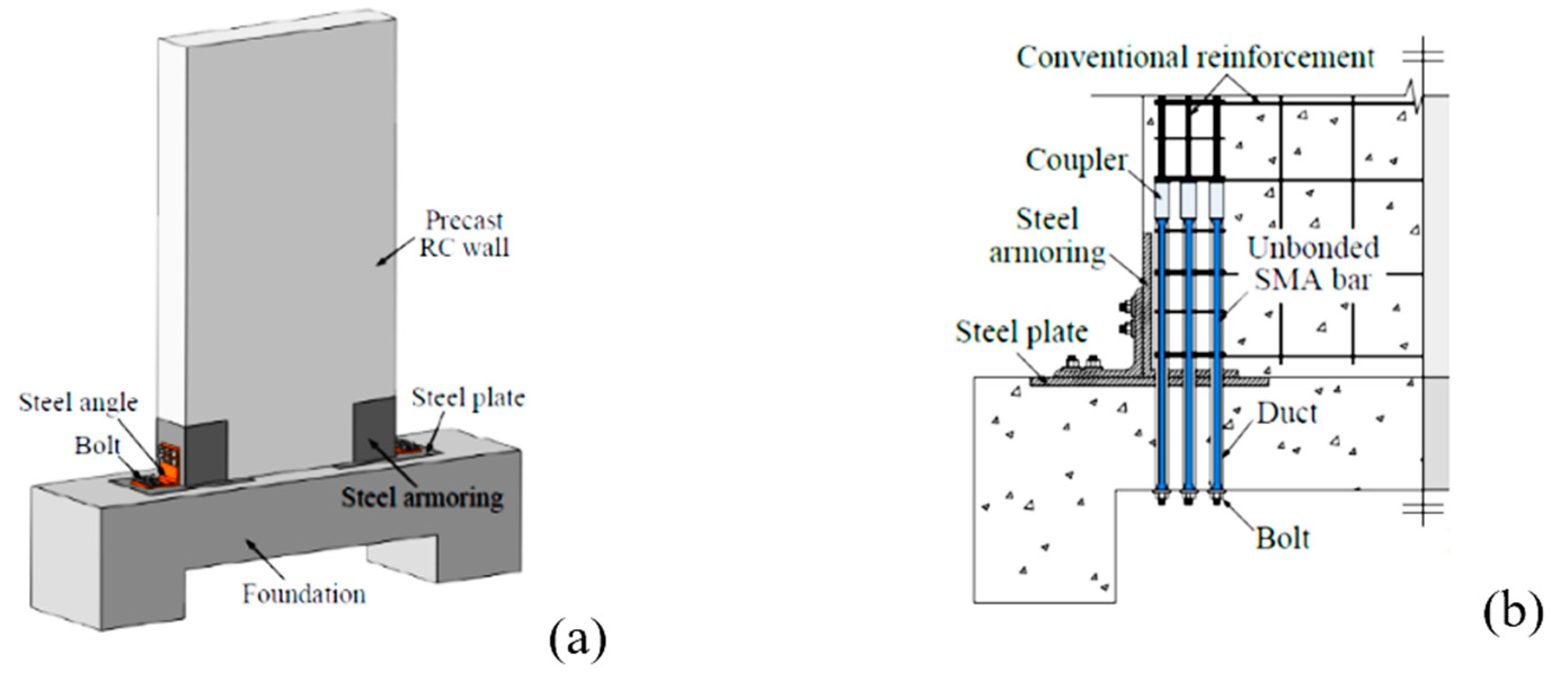

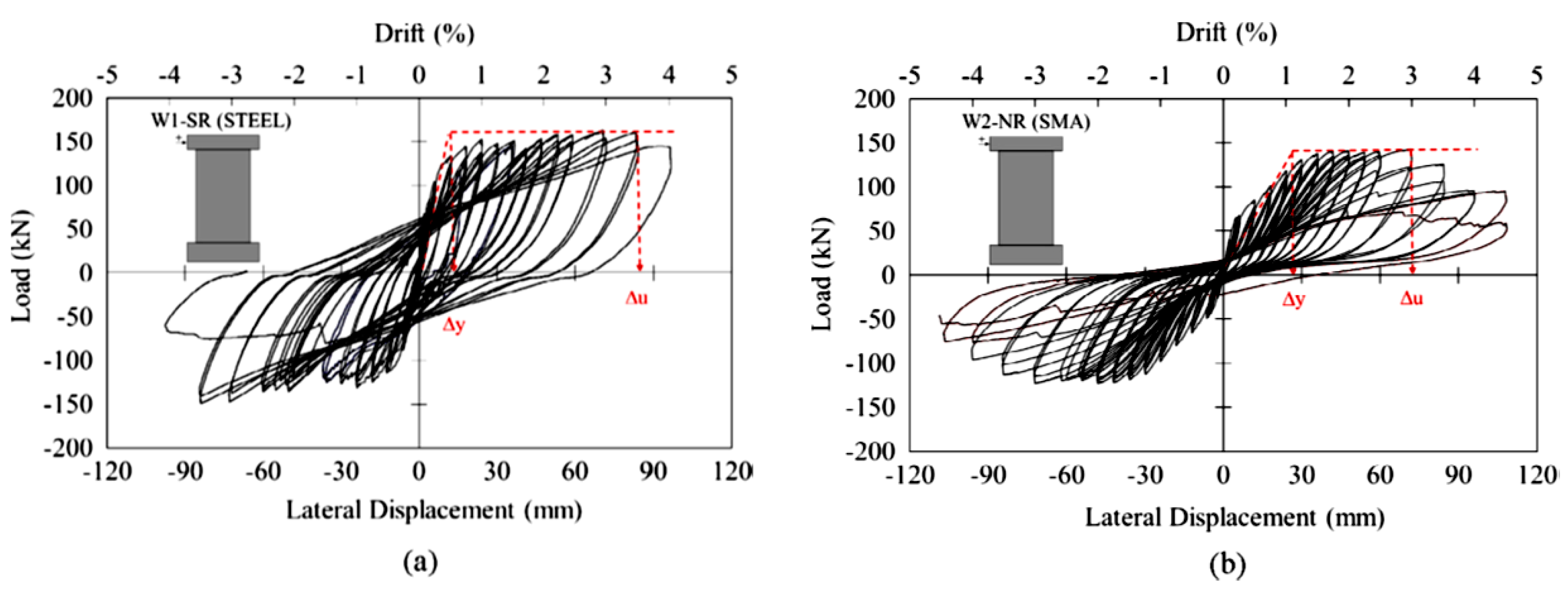

6.1.5. Bridges
6.1.6. Beams
6.2. Retrofitting Applications
6.2.1. Retrofitting Applications under Static Gravity Loads
6.2.2. Retrofitting Applications under Lateral Cyclic Loading
6.3. Self-Healing Applications
6.4. Fire Protection Applications
7. Conclusions
8. Recommendations and Future Opportunities
- Bond behavior of SMA bars with concrete.
- Optimal design of concrete structures using SMAs to attain a balance between self-centering and energy dissipation capabilities.
- New processing technologies for manufacturing SMAs at lower costs.
- Hybridization of SMA with reinforcing steel to achieve optimal performance.
- More studies on the properties of coupled SMA–steel reinforcement system under corrosive environment.
- The concept of using SMA fibers for prestressing cementitious materials in civil engineering.
- New guidelines should be established to identify the amount of SMA needed for enhancing the performance of RC structures.
- The numerical modeling of SMA concrete structures should be linked to laboratory experiments to foster their applications in building industry.
Author Contributions
Funding
Data Availability Statement
Acknowledgments
Conflicts of Interest
References
- Mohd Jani, J.; Leary, M.; Subic, A.; Gibson, M.A. A review of shape memory alloy research, applications and opportunities. Mater. Des. 2014, 56, 1078–1113. [Google Scholar] [CrossRef]
- Kundu, A.; Banerjee, A. Coupled thermomechanical modelling of shape memory alloy structures undergoing large deformation. Int. J. Mech. Sci. 2022, 220, 107102. [Google Scholar] [CrossRef]
- Chowdhury, P.; Sehitoglu, H. Deformation physics of Shape Memory Alloys—Fundamentals at atomistic frontier. Prog. Mater. Sci. 2017, 88, 49–88. [Google Scholar] [CrossRef]
- Ghosh, P.; Rao, A.; Srinivasa, A.R. Design of multi-state and smart-bias components using shape memory alloy and shape memory polymer composites. Mater. Des. 2013, 44, 164–171. [Google Scholar] [CrossRef]
- Hurlebaus, S.; Gaul, L. Smart Structure Dynamics. Mech. Syst. Signal Process 2006, 20, 255–281. [Google Scholar] [CrossRef]
- Birman, V. Review of mechanics of shape memory alloy structures. Appl. Mech. Rev. 1997, 50, 629–645. [Google Scholar] [CrossRef]
- Graesser, E.J.; Cozzarelli, F.A. Shape-memory alloys as new materials for aseismic isolation. J. Eng. Mech. 1991, 117, 2590–2608. [Google Scholar] [CrossRef]
- GVR. Shape Memory Alloys Market Size, Share & Trends Analysis Report by Product, By End Use (Biomedical, Aerospace & Defense, Automotive, Consumer Electronics & Household) By Region, And Segment Forecasts 2019–2025. 2019. Available online: https://www.grandviewresearch.com/industry-analysis/shape-memory-alloys-market (accessed on 5 May 2023).
- Fang, C. SMAs for infrastructures in Seismic Zones: A critical review of latest trends and future needs. J. Build. Eng. 2022, 57, 104918. [Google Scholar] [CrossRef]
- Zareie, S.; Issa, A.S.; Seethaler, R.J.; Zabihollah, A. Recent advances in the applications of shape memory alloys in civil infrastructures: A Review. Structures 2020, 27, 1535–1550. [Google Scholar] [CrossRef]
- Jung, D.; Wilcoski, J.; Andrawes, B. Bidirectional shake table testing of RC columns retrofitted and repaired with shape memory alloy spirals. Eng. Struct. 2018, 160, 171–185. [Google Scholar] [CrossRef]
- ASTM F2516-22; Standard Test Method for Tension Testing of Nickel-Titanium Superelastic Materials. ASTM International: West Conshohocken, PA, USA, 2022.
- Khan, M.; Pequegnat, A.; Zhou, Y. Multiple Memory Shape Memory Alloys. Adv. Eng. Mater. 2013, 15, 386–393. [Google Scholar] [CrossRef]
- Wu, M.H.; Schetky, L.M. Industrial applications for shape memory alloys. In Proceedings of the International Conference on Shape Memory and Superelastic Technologies, Pacific Grove, CA, USA, 30 April–4 May 2000; pp. 171–182. [Google Scholar]
- Otsuka, K.; Ren, X. Recent developments in the research of Shape Memory Alloys. Intermetallics 1999, 7, 511–528. [Google Scholar] [CrossRef]
- Van Humbeeck, J. Shape memory alloys: A material and a Technology. Adv. Eng. Mater. 2001, 3, 837. [Google Scholar] [CrossRef]
- Bellouard, Y. Shape memory alloys for microsystems: A review from a material research perspective. Mater. Sci. Eng. A 2008, 481–482, 582–589. [Google Scholar] [CrossRef]
- Ozbulut, O.E.; Hurlebaus, S.; Desroches, R. Seismic response control using Shape memory alloys: A review. J. Intell. Mater. Syst. Struct. 2011, 22, 1531–1549. [Google Scholar] [CrossRef]
- Duerig, T.W. Engineering Aspects of Shape Memory Alloys; Butterworth-Heinemann: London, UK, 1990; Volume 20. [Google Scholar]
- Choi, E.; Joo Kim, D.; Youn, H.; Nam, T. Repairing cracks developed in mortar beams reinforced by cold-drawn NiTi or NiTiNb SMA fibers. Smart Mater. Struct. 2015, 24, 125010. [Google Scholar] [CrossRef]
- Shrestha, K.; Araki, Y.; Nagae, T.; Koetaka, Y.; Suzuki, Y.; Omori, T.; Sutou, Y.; Kainuma, R.; Ishida, K. Feasibility of Cu–Al–Mn superelastic alloy bars as reinforcement elements in concrete beams. Smart Mater. Struct. 2013, 22, 025025. [Google Scholar] [CrossRef]
- Michels, J.; Shahverdi, M.; Czaderski, C.; El-Hacha, R. Mechanical Performance of Fe-SMA Ribbed Bars for Concrete Prestressing. ACI Mater. J. 2018, 115, 6. [Google Scholar] [CrossRef]
- Santosh, S.; Srivatsan, S.; Vignesh Pandian, R. Unravelling the Effect of CO2 Laser Machining Parameters on the Surface and Shape Memory Characteristics of CuAlFeMn Quaternary Shape Memory Alloy. Opt. Laser Technol. 2023, 163, 109306. [Google Scholar] [CrossRef]
- Vollmer, M.; Elahinia, M.; Morsali, S.R.; Moghaddam, N.S. Novel Prestressing Applications in Civil Engineering Structures Enabled by Fe-Mn-Al-Ni Shape Memory Alloys. Eng. Struct. 2021, 241, 112430. [Google Scholar] [CrossRef]
- Sampath, S.; Vedamanickam, S. Effect of Vanadium on the Microstructure, Transformation Temperatures, and Corrosion Behavior of NiTi Shape Memory Alloys. J. Eng. Mater. Technol. 2022, 145, 011009. [Google Scholar] [CrossRef]
- Seo, J.; Kim, Y.; Hu, J. Pilot study for investigating the cyclic behavior of slit damper systems with recentering shape memory alloy (SMA) bending bars used for seismic restrainers. Appl. Sci. 2015, 5, 187–208. [Google Scholar] [CrossRef]
- Sherif, M.; Khakimova, E.; Ozbulut, O.; Harris, D.; Ozyildirim, H. Behavior of Mortar Beams with Randomly Distributed Superelastic Shape Memory Alloy Fibers. J. Intell. Mater. Syst. Struct. 2017, 29, 684–695. [Google Scholar] [CrossRef]
- Shajil, N.; Srinivasan, S.; Santhanam, M. Self-Centering of Shape Memory Alloy Fiber Reinforced Cement Mortar Members Subjected to Strong Cyclic Loading. Mater. Struct. 2013, 46, 651–661. [Google Scholar] [CrossRef]
- Kuang, Y.; Ou, J. Passive Smart Self-Repairing Concrete Beams by Using Shape Memory Alloy Wires and Fibers Containing Adhesives. J. Cent. South Univ. Technol. 2008, 15, 411–417. [Google Scholar] [CrossRef]
- Suhail, R.; Amato, G.; Broderick, B.; Grimes, M.; McCrum, D. Efficacy of Prestressed SMA Diagonal Loops in Seismic Retrofitting of Non-Seismically Detailed RC Beam-Column Joints. Eng. Struct. 2021, 245, 112937. [Google Scholar] [CrossRef]
- Sinha, A.; Tatar, N.; Tatar, J. Rapid Heat-Activated Post-Tensioning of Damaged Reinforced Concrete Girders with Unbonded Near-Surface Mounted (NSM) NiTiNb Shape-Memory Alloy Wires. Mater. Struct. 2020, 53, 4. [Google Scholar] [CrossRef]
- Oudah, F.; El-Hacha, R. Plastic Hinge Relocation in Concrete Structures Using the Double-Slotted-Beam System. Bull. Earthquake Eng. 2015, 15, 2173–2199. [Google Scholar] [CrossRef]
- Youssef, M.; Alam, M.; Nehdi, M. Experimental Investigation on the Seismic Behavior of Beam-Column Joints Reinforced with Superelastic Shape Memory Alloys. J. Earthq. Eng. 2008, 12, 1205–1222. [Google Scholar] [CrossRef]
- Miralami, M.; Esfahani, M.; Tavakkolizadeh, M. Strengthening of Circular RC Column-Foundation Connections with GFRP/SMA Bars and CFRP Wraps. Compos. Part B Eng. 2019, 172, 161–172. [Google Scholar] [CrossRef]
- Abdulridha, A.; Palermo, D. Behaviour and Modelling of Hybrid SMA-Steel Reinforced Concrete Slender Shear Wall. Eng. Struct. 2017, 147, 77–89. [Google Scholar] [CrossRef]
- Wang, B.; Zhu, S.; Zhao, J.; Jiang, H. Earthquake Resilient RC Walls Using Shape Memory Alloy Bars and Replaceable Energy Dissipating Devices. Smart Mater. Struct. 2019, 28, 065021. [Google Scholar] [CrossRef]
- Muntasir Billah, A.H.M.; Rahman, J.; Zhang, Q. Shape memory alloys (SMAs) for Resilient Bridges: A state-of-the-art review. Structures 2022, 37, 514–527. [Google Scholar] [CrossRef]
- Jalaeefar, A.; Asgarian, B. Experimental investigation of mechanical properties of nitinol, structural steel, and their hybrid component. J. Mater. Civ. Eng. 2013, 25, 1498–1505. [Google Scholar] [CrossRef]
- Wolons, D.; Gandhi, F.; Malovrah, B. Experimental Investigation of the Pseudoelastic Hysteresis Damping Characteristics of Shape Memory Alloy Wires. J. Intell. Mater. Syst. Struct. 1998, 9, 116–126. [Google Scholar] [CrossRef]
- Dolce, M.; Cardone, D. Mechanical Behavior of Shape Memory Alloys for Seismic Applications 2. Austenite NiTi Bars Subjected to Tension. Int. J. Mech. Sci. 2001, 43, 2657–2677. [Google Scholar] [CrossRef]
- Tamai, H.; Kitagawa, Y. Pseudoelastic Behavior of Shape Memory Alloy Wire and Its Application to Seismic Resistance Member for Building. Comput. Mater. Sci. 2002, 25, 218–227. [Google Scholar] [CrossRef]
- DesRoches, R.; McCormick, C.; Delemont, M. Cyclic Properties of Superelastic Shape Memory Alloy Wires and Bars. J. Struct. Eng. 2004, 130, 38–46. [Google Scholar] [CrossRef]
- Malecot, P.; Lexcellent, C.; Foltête, E.; Collet, M. Shape Memory Alloys Cyclic Behavior: Experimental Study and Modeling. J. Eng. Mater. Technol. 2006, 128, 335–345. [Google Scholar] [CrossRef]
- Suhail, R.; Amato, G.; Alam, M.S.; Broderick, B.; Grimes, M.; McCrum, D. Seismic Retrofitting of Nonseismically Detailed Exterior Reinforced Concrete Beam-Column Joint by Active Confinement Using Shape Memory Alloy Wires. J. Struct. Eng. 2023, 149, 3. [Google Scholar] [CrossRef]
- Qian, H.; Wu, P.; Ren, Z.; Chen, G.; Shi, Y. Pseudo-Static Tests of Reinforced Concrete Pier Columns Confined with Pre-Tensioned Superelastic Shape Memory Alloy Wires. Eng. Struct. 2023, 280, 115680. [Google Scholar] [CrossRef]
- Abraik, E. Seismic Performance of Shape Memory Alloy Reinforced Concrete Moment Frames under Sequential Seismic Hazard. Structures 2020, 26, 311–326. [Google Scholar] [CrossRef]
- Azadi, B.; Rajapakse, R.K.N.D.; Maijer, D.M. One-Dimensional Thermomechanical Model for Dynamic Pseudoelastic Response of Shape Memory Alloys. Smart Mater. Struct. 2006, 15, 996–1008. [Google Scholar] [CrossRef]
- Wu, K.; Yang, F.; Pu, Z.; Shi, J. The Effect of Strain Rate on Detwinning and Superelastic Behavior of NiTi Shape Memory Alloys. J. Intell. Mater. Syst. Struct. 1996, 7, 138–144. [Google Scholar] [CrossRef]
- Schmidt, I.; Lammering, R. The Damping Behavior of Superelastic NiTi Components. Mater. Sci. Eng. A 2004, 378, 70–75. [Google Scholar] [CrossRef]
- Alam, M.S.; Youssef, M.A.; Nehdi, M. Analytical Prediction of the Seismic Behavior of Superelastic Shape Memory Alloy Reinforced Concrete Elements. Eng. Struct. 2008, 30, 3399–3411. [Google Scholar] [CrossRef]
- Shrestha, B.; Hao, H. Parametric Study of Seismic Performance of Super-Elastic Shape Memory Alloy-Reinforced Bridge Piers. Struct. Infrastruct. Eng. 2015, 12, 1076–1089. [Google Scholar] [CrossRef]
- Ren, W.; Li, H.; Song, G. A One-Dimensional Strain-Rate-Dependent Constitutive Model for Superelastic Shape Memory Alloys. Smart Mater. Struct. 2007, 16, 191–197. [Google Scholar] [CrossRef]
- Tobushi, H.; Shimeno, Y.; Hachisuka, T.; Tanaka, K. Influence of Strain Rate on Superelastic Properties of TiNi Shape Memory Alloy. Mech. Mater. 1998, 30, 141–150. [Google Scholar] [CrossRef]
- Saigal, A.; Fonte, M. Solid, Shape Recovered “Bulk” Nitinol: Part I—Tension–Compression Asymmetry. Mater. Sci. Eng. A 2011, 528, 5536–5550. [Google Scholar] [CrossRef]
- Piedboeuf, M.C.; Gauvin, R.; Thomas, M. Damping Behavior of Shape Memory Alloys: Strain Amplitude, Frequency, and Temperature Effects. J. Sound Vib. 1998, 214, 885–901. [Google Scholar] [CrossRef]
- Chang, B.C.; Shaw, J.A.; Iadicola, M.A. Thermodynamics of Shape Memory Alloy Wire: Modeling, Experiments, and Application. Contin. Mech. Thermodyn. 2006, 18, 83–118. [Google Scholar] [CrossRef]
- Chen, W.; Song, B. Temperature Dependence of a NiTi Shape Memory Alloy’s Superelastic Behavior at a High Strain Rate. J. Mech. Mater. Struct. 2006, 1, 339–356. [Google Scholar] [CrossRef]
- Churchill, C.B.; Shaw, J.A.; Iadicola, M.A. Tips and Tricks for Characterizing Shape Memory Alloy Wire: Part 2- Fundamental Isothermal Responses. Exp. Technol. 2009, 33, 51–62. [Google Scholar] [CrossRef]
- Sadiq, H.; Wong, M.; Al-Mahaidi, R.; Zhao, X. A Novel Active Fire Protection Approach for Structural Steel Members Using NiTi Shape Memory Alloy. Smart Mater. Struct. 2013, 22, 025033. [Google Scholar] [CrossRef]
- Zhao, H.; Andrawes, B. Mechanical Properties of NiTiNb Shape Memory Alloy Subjected to a Harsh Corrosive Environment. J. Mater. Civ. Eng. 2017, 29, 04016201. [Google Scholar] [CrossRef]
- Joo, J.; Kang, M.; Shin, D.; Seo, E.; Kim, D.; Yeon, Y.; Hong, K.; Lee, W.; Lee, J. Corrosion Resistance of Shape Recoverable Fe-17Mn-5Si-5Cr Alloy in Concrete Structures. Materials 2020, 13, 5531. [Google Scholar] [CrossRef] [PubMed]
- Abo Alarab, L.; Ross, B.; Poursaee, A. Corrosion Assessment of Coupled Steel Reinforcement with Ni-Ti–Based Shape Memory Alloy in Simulated-Concrete Pore Solution. J. Mater. Civ. Eng. 2016, 28, 04015138. [Google Scholar] [CrossRef]
- Molod, M.A.; Spyridis, P.; Barthold, F.-J. Applications of Shape Memory Alloys in Structural Engineering with a Focus on Concrete Construction—A Comprehensive Review. Constr. Build. Mater. 2022, 337, 127565. [Google Scholar] [CrossRef]
- Tabrizikahou, A.; Kuczma, M.; Łasecka-Plura, M.; Noroozinejad Farsangi, E.; Noori, M.; Gardoni, P.; Li, S. Application and Modelling of Shape-Memory Alloys for Structural Vibration Control: State-of-the-Art Review. Constr. Build. Mater. 2022, 342, 127975. [Google Scholar] [CrossRef]
- Mirzaey, E.; Shaikh, M.R.; Rasheed, M.; Ughade, A.; Khan, H.A.; Shaw, S.K. Shape Memory Alloy Reinforcement for Strengthening of RCC Structures—A Critical Review. Mater. Today Proc. 2023, 51, 633–640. [Google Scholar] [CrossRef]
- Qiang, X.; Wu, Y.; Wang, Y.; Jiang, X. Research Progress and Applications of Fe-Mn-Si-Based Shape Memory Alloys on Reinforcing Steel and Concrete Bridges. Appl. Sci. 2023, 13, 3404. [Google Scholar] [CrossRef]
- Auricchio, F.; Taylor, R.L. Shape-Memory Alloys: Modeling and Numerical Simulations of the Finite-Strain Superelastic Behavior. Comput. Methods Appl. Mech. Eng. 1996, 143, 175–194. [Google Scholar] [CrossRef]
- Auricchio, F.; Lubliner, J. Shape-Memory Alloys: Macromodelling and Numerical Simulations of the Superelastic Behavior. Comput. Methods Appl. Mech. Eng. 1997, 146, 281–312. [Google Scholar] [CrossRef]
- Raza, S.; Shafei, B.; Saiid Saiidi, M.; Motavalli, M.; Shahverdi, M. Shape Memory Alloy Reinforcement for Strengthening and Self-Centering of Concrete Structures-State of the Art. Constr. Build. Mater. 2022, 324, 126628. [Google Scholar] [CrossRef]
- Saadat, S.; Salichs, J.; Noori, M.; Hou, Z.; Davoodi, H.; Bar-on, I.; Suzuki, Y.; Masuda, A. An Overview of Vibration and Seismic Application of NiTi Shape Memory Alloy. Smart Mater. Struct. 2002, 11, 218–229. [Google Scholar] [CrossRef]
- DesRoches, R.; Smith, B. Shape Memory Alloys in Seismic Resistant Design and Retrofit: A Critical Review of their Potential and Limitations. J. Earthq. Eng. 2004, 7, 415–429. [Google Scholar] [CrossRef]
- Janke, L.; Czaderski, C.; Motavalli, M.; Ruth, J. Applications of Shape Memory Alloys in Civil Engineering Structures—Overview, Limits and New Ideas. Mater. Struct. 2005, 38, 578–592. [Google Scholar]
- Wilson, J.C.; Wesolowsky, M.J. Shape Memory Alloys for Seismic Response Modification: A State-of-the Art Review. Earthq. Spectra 2005, 21, 569–601. [Google Scholar] [CrossRef]
- Song, G.; Ma, N.; Li, H.-N. Applications of Shape Memory Alloys in Civil Structures. Eng. Struct. 2006, 28, 1266–1274. [Google Scholar] [CrossRef]
- Kawashima, K.; MacRae, G.; Hoshikuma, J.; Nagaya, K. Residual Displacement Response Spectrum. J. Struct. Eng. 1998, 124, 523–530. [Google Scholar] [CrossRef]
- Bazzurro, P.; Cornell, C.A.; Menun, C.A.; Motahari, M. Guidelines for Seismic Assessment of Damaged Buildings. In Proceedings of the 13th World Conference on Earthquake Engineering, Vancouver, BC, Canada, 1–6 August 2004. [Google Scholar]
- Luco, N.; Bazzurro, P.; Cornell, C.A. Dynamic versus Static Computation of the Residual Capacity of a Mainshock Damaged Building to Withstand an Aftershock. In Proceedings of the 13th World Conference on Earthquake Engineering, Vancouver, BC, Canada, 1–6 August 2004. [Google Scholar]
- Miller, D.J.; Fahnestock, L.A.; Eatherton, M.R. Development and Experimental Validation of a Nickel-Titanium Shape Memory Alloy Self-Centering Buckling-Restrained Brace. Eng. Struct. 2012, 40, 288–298. [Google Scholar] [CrossRef]
- Wang, W.; Fang, C.; Yang, X.; Chen, Y.; Ricles, J.; Sause, R. Innovative Use of a Shape Memory Alloy Ring Spring System for Self-Centering Connections. Eng. Struct. 2017, 153, 503–515. [Google Scholar] [CrossRef]
- Fang, C.; Yam, M.C.H.; Chan, T.-M.; Wang, W.; Yang, X.; Lin, X. A Study of Hybrid Self-Centring Connections Equipped with Shape Memory Alloy Washers and Bolts. Eng. Struct. 2018, 164, 155–168. [Google Scholar] [CrossRef]
- Askariani, S.S.; Garivani, S.; Hajirasouliha, I.; Soleimanian, N. Innovative Self-Centering Systems Using Shape Memory Alloy Bolts and Energy Dissipating Devices. J. Constr. Steel Res. 2022, 190, 107127. [Google Scholar] [CrossRef]
- Farmani, M.A.; Ghassemieh, M. Shape Memory Alloy-Based Moment Connections with Superior Self-Centering Properties. Smart Mater. Struct. 2016, 25, 075028. [Google Scholar] [CrossRef]
- Wang, B.; Zhu, S. Seismic Behavior of Self-Centering Reinforced Concrete Wall Enabled by Superelastic Shape Memory Alloy Bars. Bull. Earthq. Eng. 2017, 16, 479–502. [Google Scholar] [CrossRef]
- Aryan, H. Seismic Resistant Bridge Columns with NiTi Shape Memory Alloy and Ultra-High-Performance Concrete. Infrastructures 2020, 5, 105. [Google Scholar] [CrossRef]
- Khan, M.S. Seismic Performance of Deficient RC Frames Retrofitted with SMA-Reinforced ECC Column Jacketing. Innov. Infrastruct. Sol. 2021, 6, 69. [Google Scholar] [CrossRef]
- Rahman Bhuiyan, A.; Alam, M. Seismic Performance Assessment of Highway Bridges Equipped with Superelastic Shape Memory Alloy-Based Laminated Rubber Isolation Bearing. Eng. Struct. 2013, 49, 396–407. [Google Scholar] [CrossRef]
- Xiang, N.; Chen, X.; Alam, M.S. Probabilistic Seismic Fragility and Loss Analysis of Concrete Bridge Piers with Superelastic Shape Memory Alloy-Steel Coupled Reinforcing Bars. Eng. Struct. 2020, 207, 110229. [Google Scholar] [CrossRef]
- Effendy, E.; Liao, W.I.; Song, G.; Mo, Y.L.; Loh, C.H. Seismic Behavior of Low-Rise Shear Walls with SMA Bars. In Earth & Space 2006: Engineering, Construction, and Operations in Challenging Environment; ASCE Library: Reston, VA, USA, 2006; pp. 1–18. [Google Scholar]
- Abdulridha, A.; Palermo, D.; Foo, S.; Vecchio, F. Behavior and Modeling of Superelastic Shape Memory Alloy Reinforced Concrete Beams. Eng. Struct. 2013, 49, 893–904. [Google Scholar] [CrossRef]
- Li, M.; Liu, J.; Yan, S.; Yan, W.; Shi, B. Effect of Aging Treatment on Damping Capacity in Cu-Al-Mn Shape Memory Alloy. J. Alloys Compd. 2020, 821, 153213. [Google Scholar] [CrossRef]
- DesRoches, R.; Delemont, M. Seismic Retrofit of Simply Supported Bridges Using Shape Memory Alloys. Eng. Struct. 2002, 24, 325–332. [Google Scholar] [CrossRef]
- Zheng, Y.; Fang, C.; Liang, D.; Sun, R. An Innovative Seismic-Resilient Bridge with Shape Memory Alloy-Washer-Based Footing Rocking RC Piers. J. Intell. Mater. Syst. Struct. 2020, 32, 549–567. [Google Scholar] [CrossRef]
- Zhou, P.; Liu, M.; Li, H.; Song, G. Experimental Investigations on Seismic Control of Cable-Stayed Bridges Using Shape Memory Alloy Self-Centering Dampers. Struct. Control Health Monit. 2018, 25, 7. [Google Scholar] [CrossRef]
- Johnson, R.; Padgett, J.; Emmanuel Maragakis, M.; DesRoches, R.; Saiidi, M.S. Large Scale Testing of Nitinol Shape Memory Alloy Devices for Retrofitting of Bridges. Smart Mater. Struct. 2008, 17, 035018. [Google Scholar] [CrossRef]
- Saiidi, S.; O’Brien, M.; Sadrossadat-Zadeh, M. Cyclic Response of Concrete Bridge Columns Using Superelastic Nitinol and Bendable Concrete. ACI Struct. J. 2009, 106, 69–77. [Google Scholar]
- Cruz Noguez, C.A.; Saiidi, M.S. Shake-Table Studies of a Four-Span Bridge Model with Advanced Materials. J. Struct. Eng. 2012, 138, 183–192. [Google Scholar] [CrossRef]
- Roh, H.; Reinhorn, A.M. Hysteretic Behavior of Precast Segmental Bridge Piers with Superelastic Shape Memory Alloy Bars. Eng. Struct. 2010, 32, 3394–3403. [Google Scholar] [CrossRef]
- Muntasir Billah, A.H.; Alam, M.S. Seismic Fragility Assessment of Concrete Bridge Pier Reinforced with Superelastic Shape Memory Alloy. Earthq. Spectra 2015, 31, 1515–1541. [Google Scholar] [CrossRef]
- Andrawes, B.; DesRoches, R. Comparison between Shape Memory Alloy Seismic Restrainers and Other Bridge Retrofit Devices. J. Bridge Eng. 2007, 12, 700–709. [Google Scholar] [CrossRef]
- Wilde, K.; Gardoni, P.; Fujino, Y. Base Isolation System with Shape Memory Alloy Device for Elevated Highway Bridges. Eng. Struct. 2000, 22, 222–229. [Google Scholar] [CrossRef]
- Hong, C.; Qian, H.; Song, G. Uniaxial Compressive Behavior of Concrete Columns Confined with Superelastic Shape Memory Alloy Wires. Materials 2020, 13, 1227. [Google Scholar] [CrossRef] [PubMed]
- Yurdakul, Ö.; Tunaboyu, O.; Avşar, Ö. Retrofit of Non-Seismically Designed Beam-Column Joints by Post-Tensioned Superelastic Shape Memory Alloy Bars. Bull. Earthq. Eng. 2018, 16, 5279–5307. [Google Scholar] [CrossRef]
- Wong, B.; Liu, J. A Hybrid Steel-Shape Memory Alloy Reinforced Concrete Beam Design for Optimum Fire Resistance Capacity. Mag. Concr. Res. 2015, 67, 1–10. [Google Scholar] [CrossRef]
- Jia, Y.; Lu, Z.; Li, L.; Wang, C. A Hybrid Steel-Shape Memory Alloy Prestressed Concrete Beam for Improved Fire Resistance. Struct. Control Health Monit. 2020, 27, 10. [Google Scholar] [CrossRef]
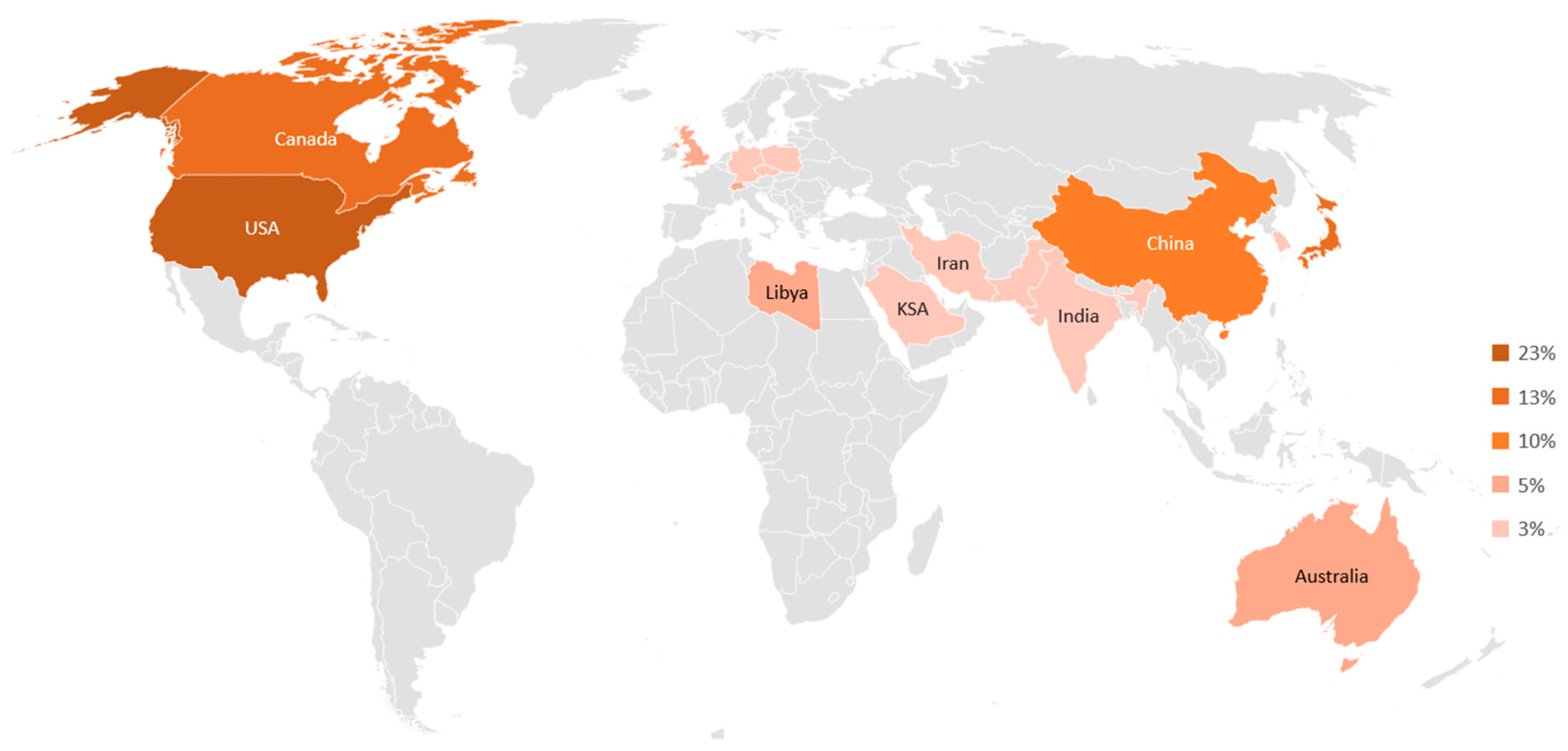
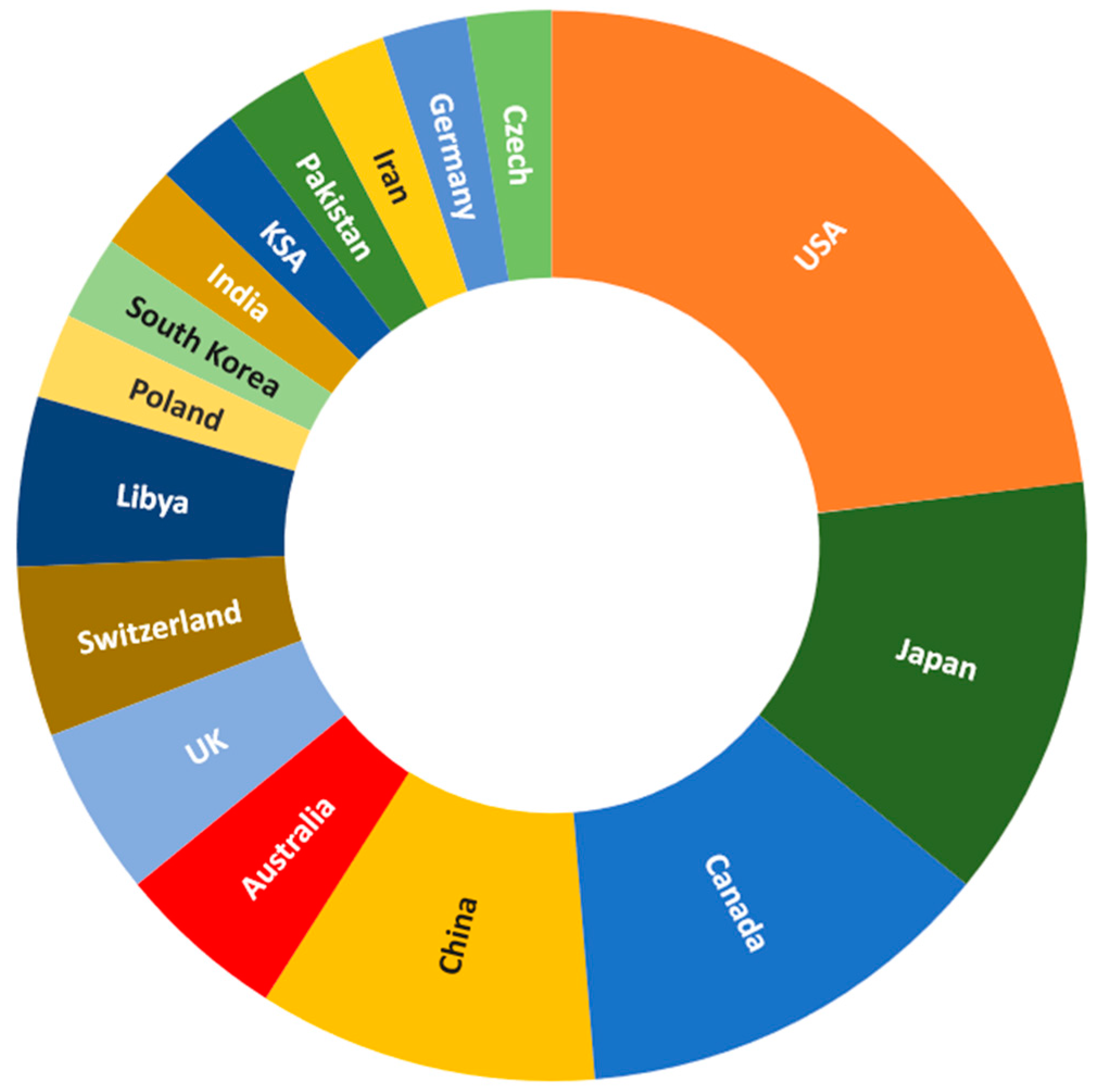
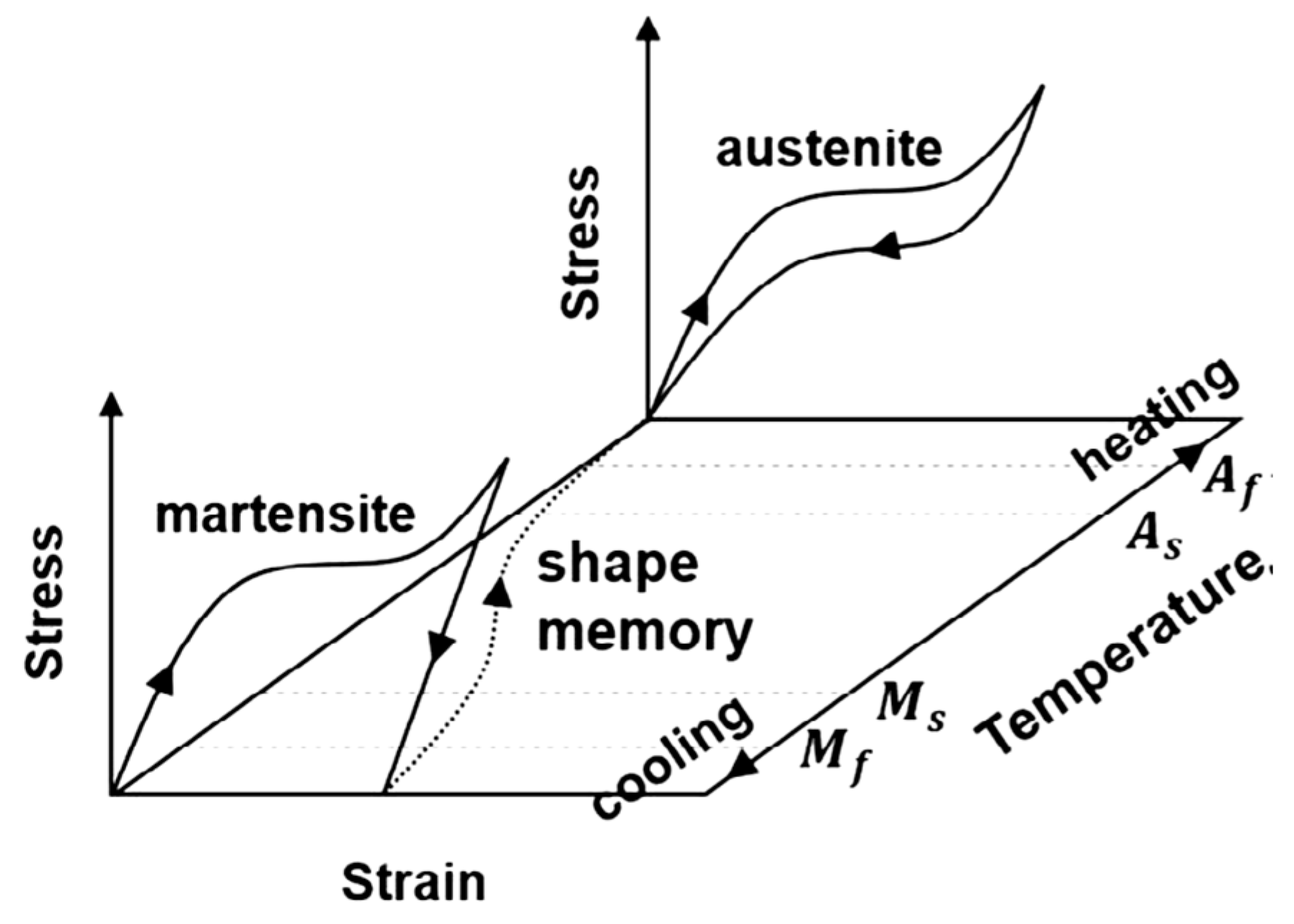
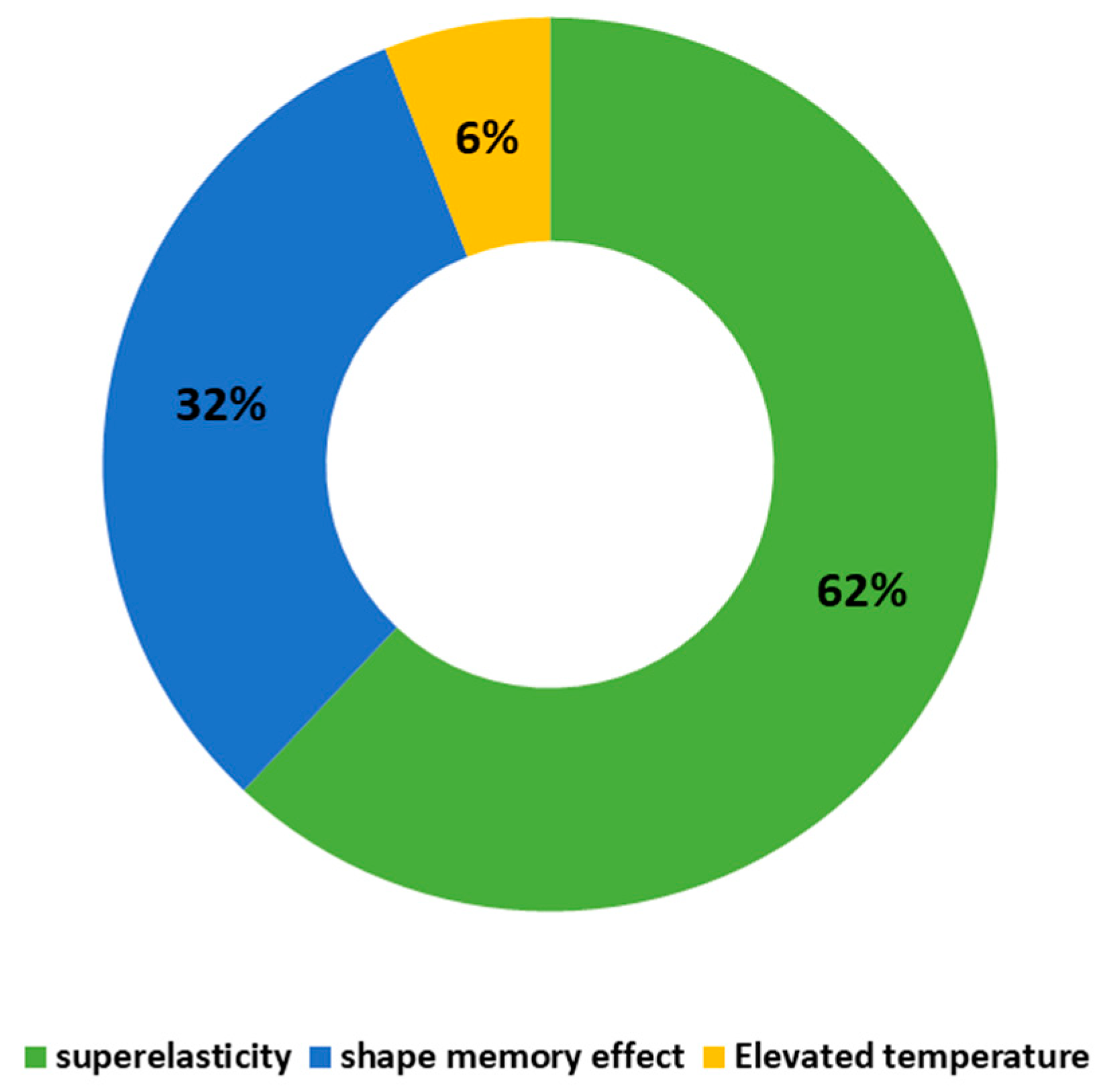


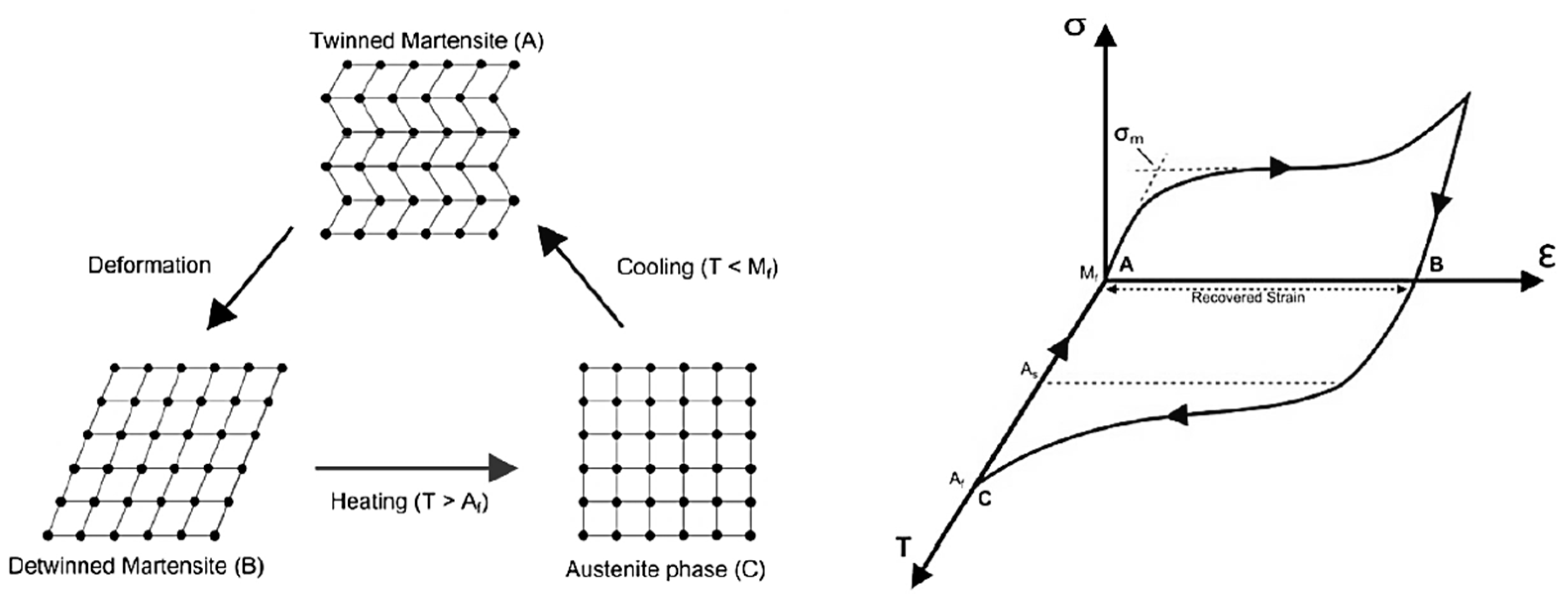

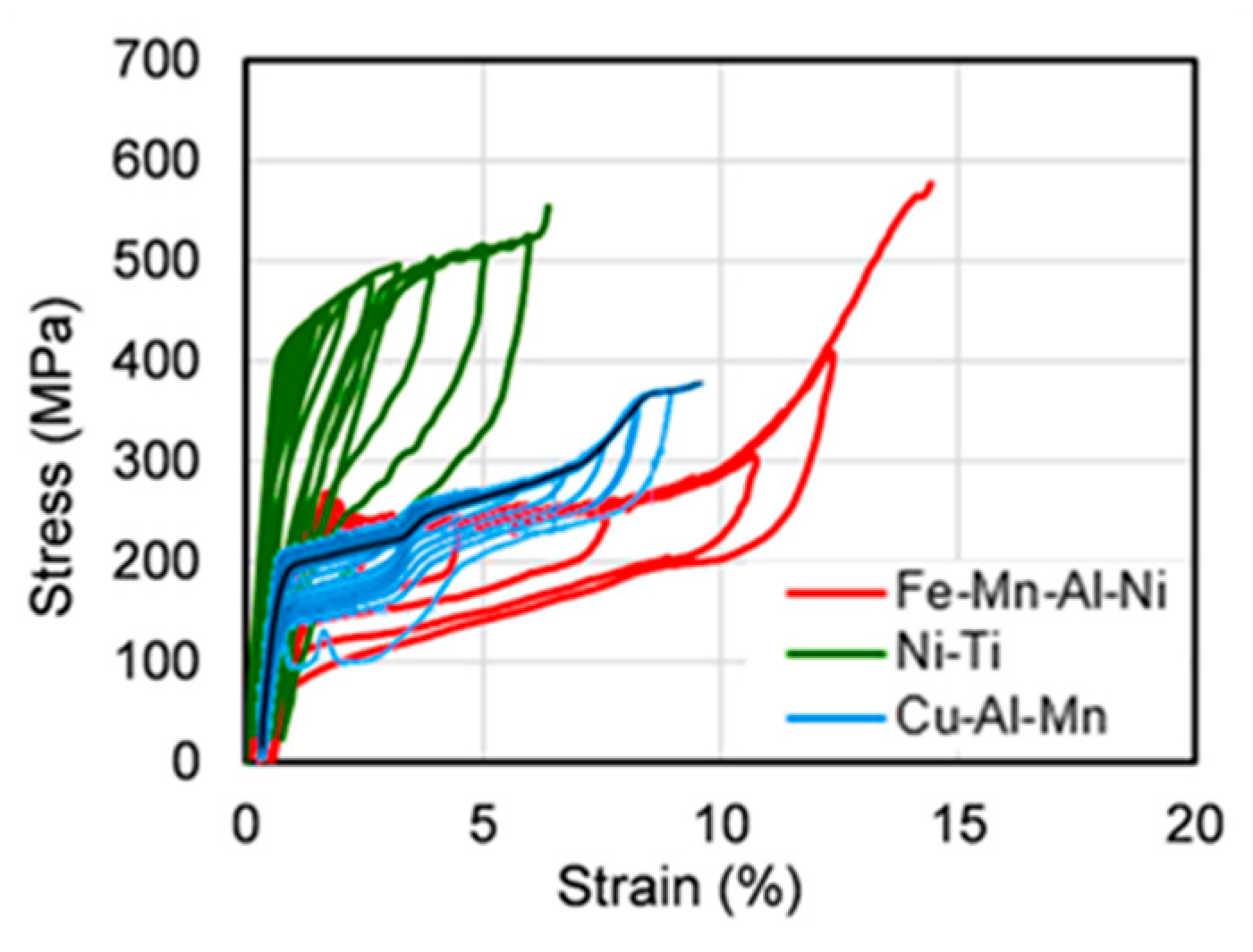
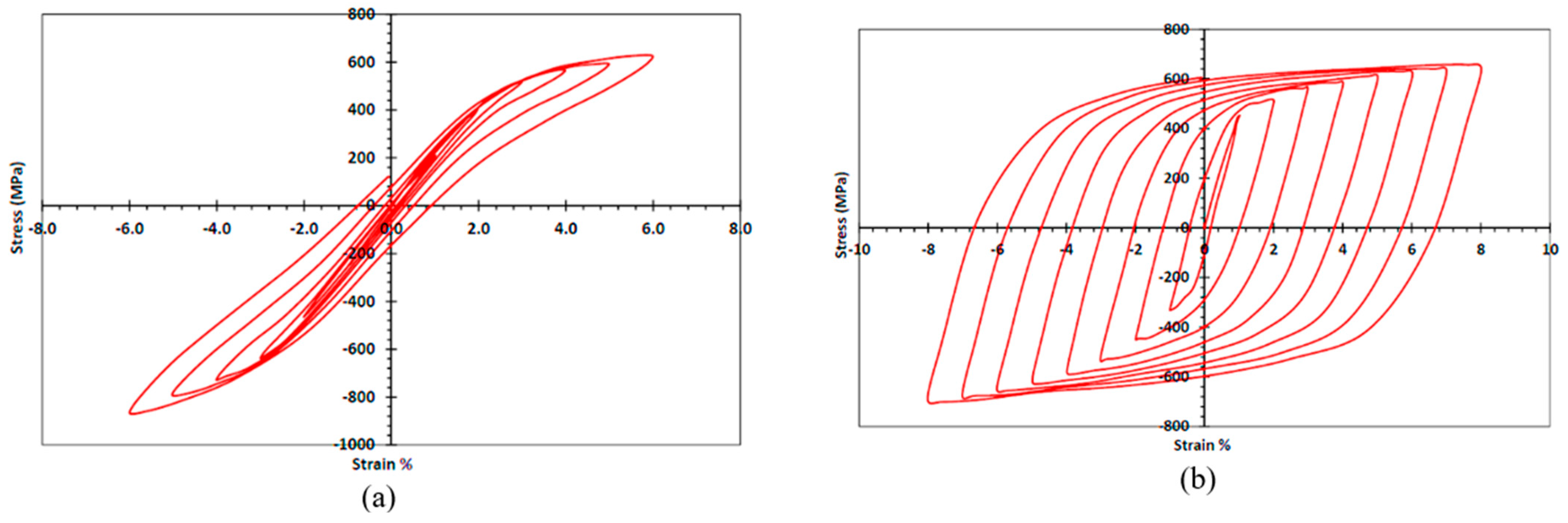
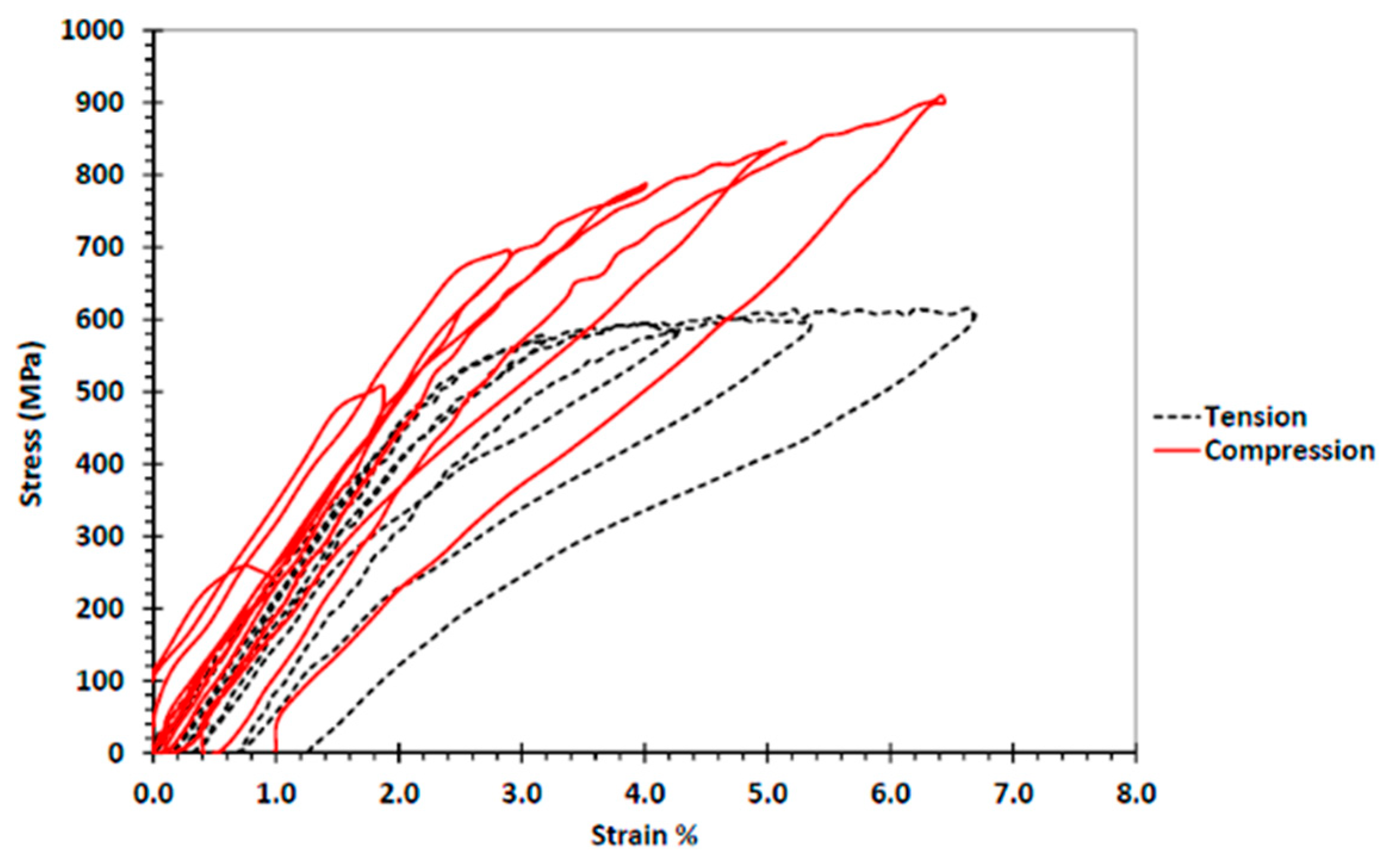
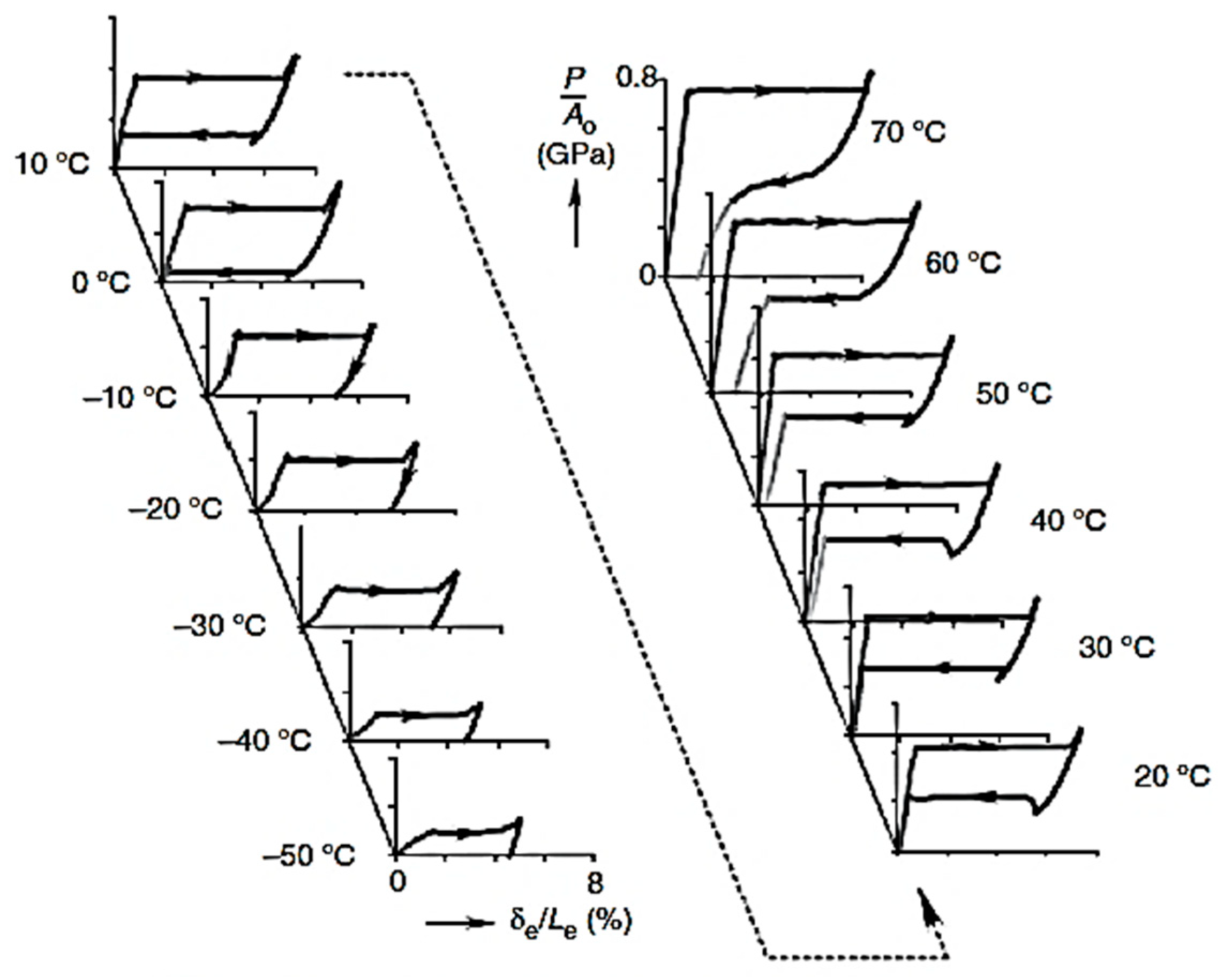
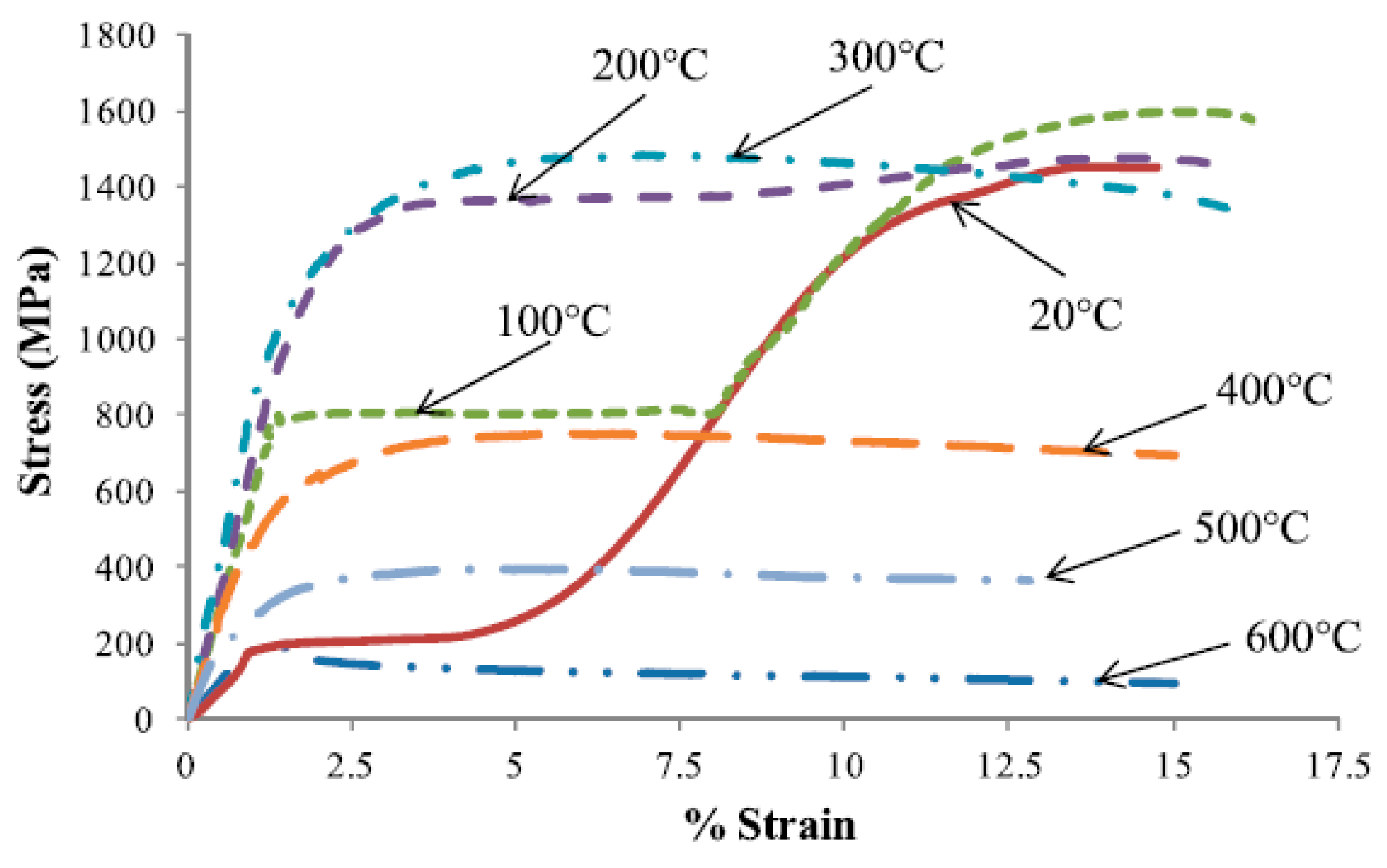
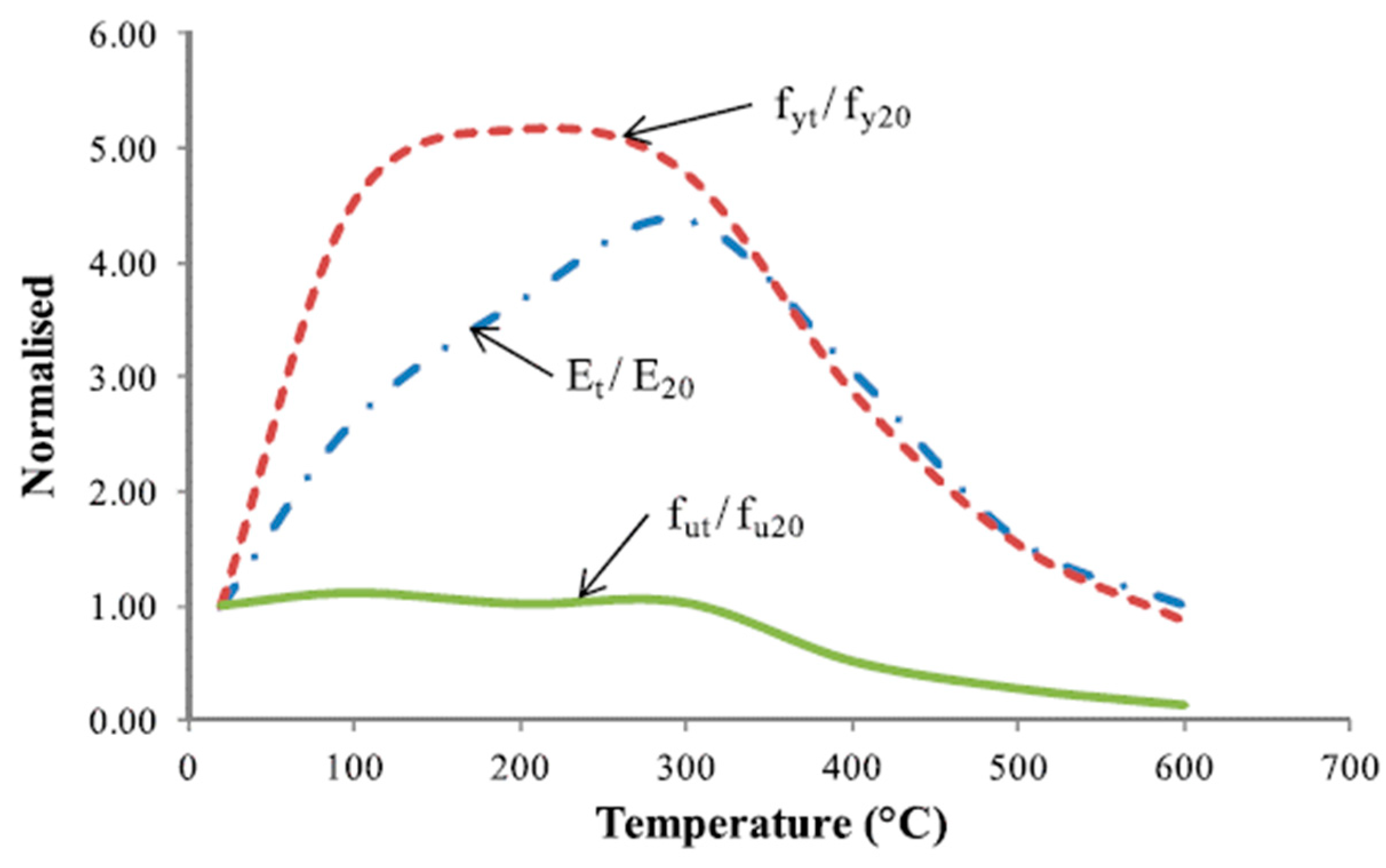
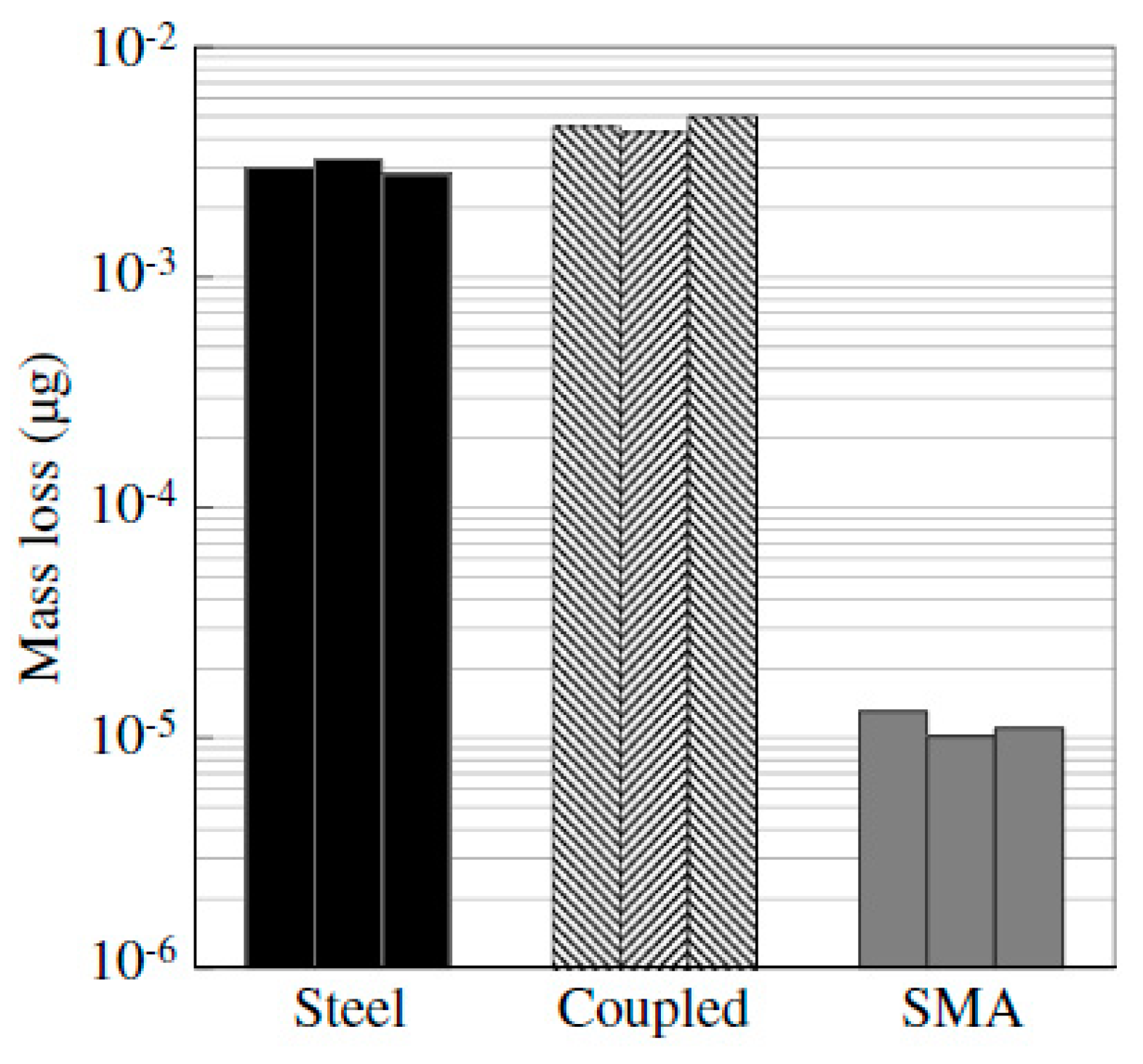
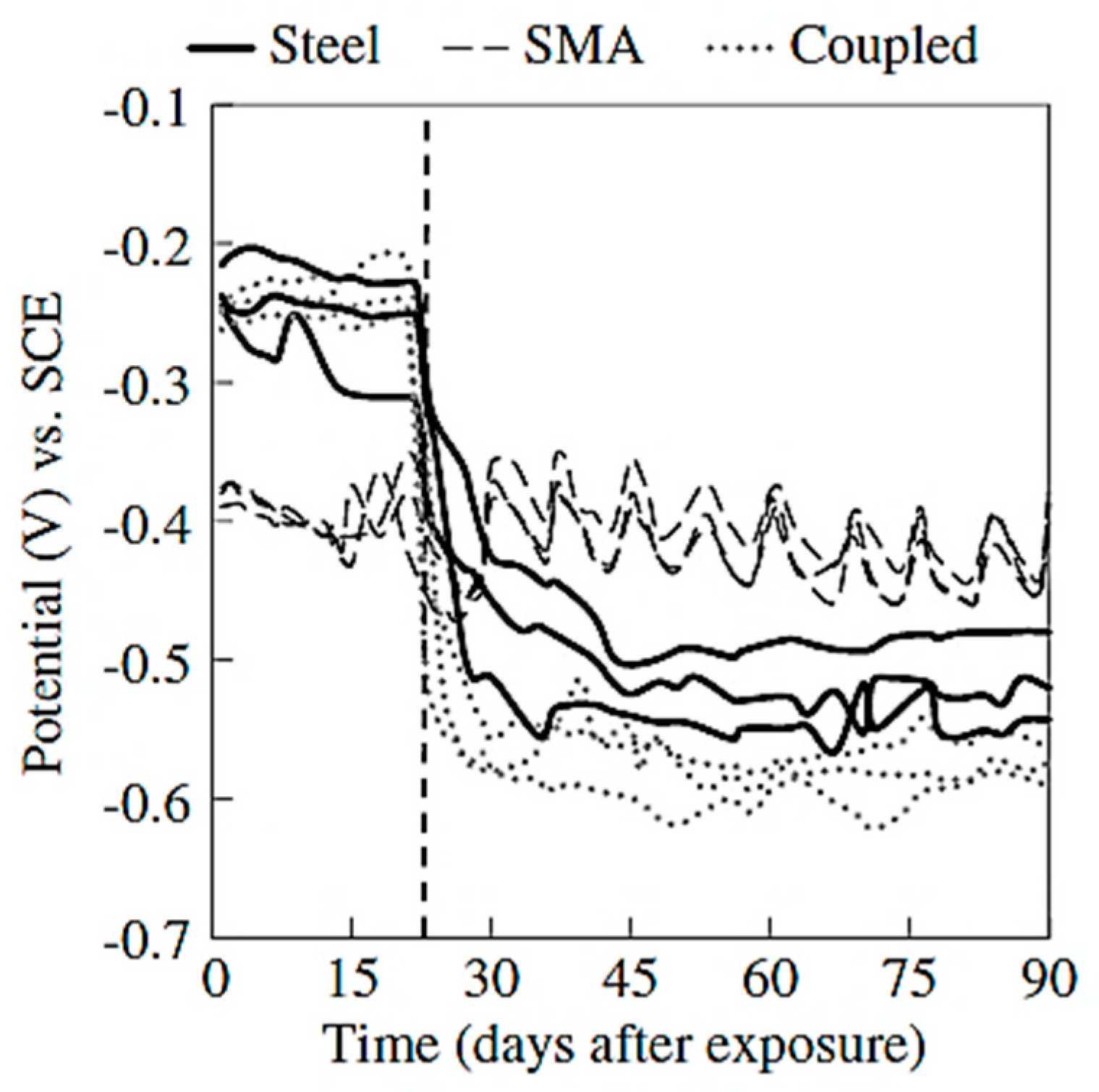
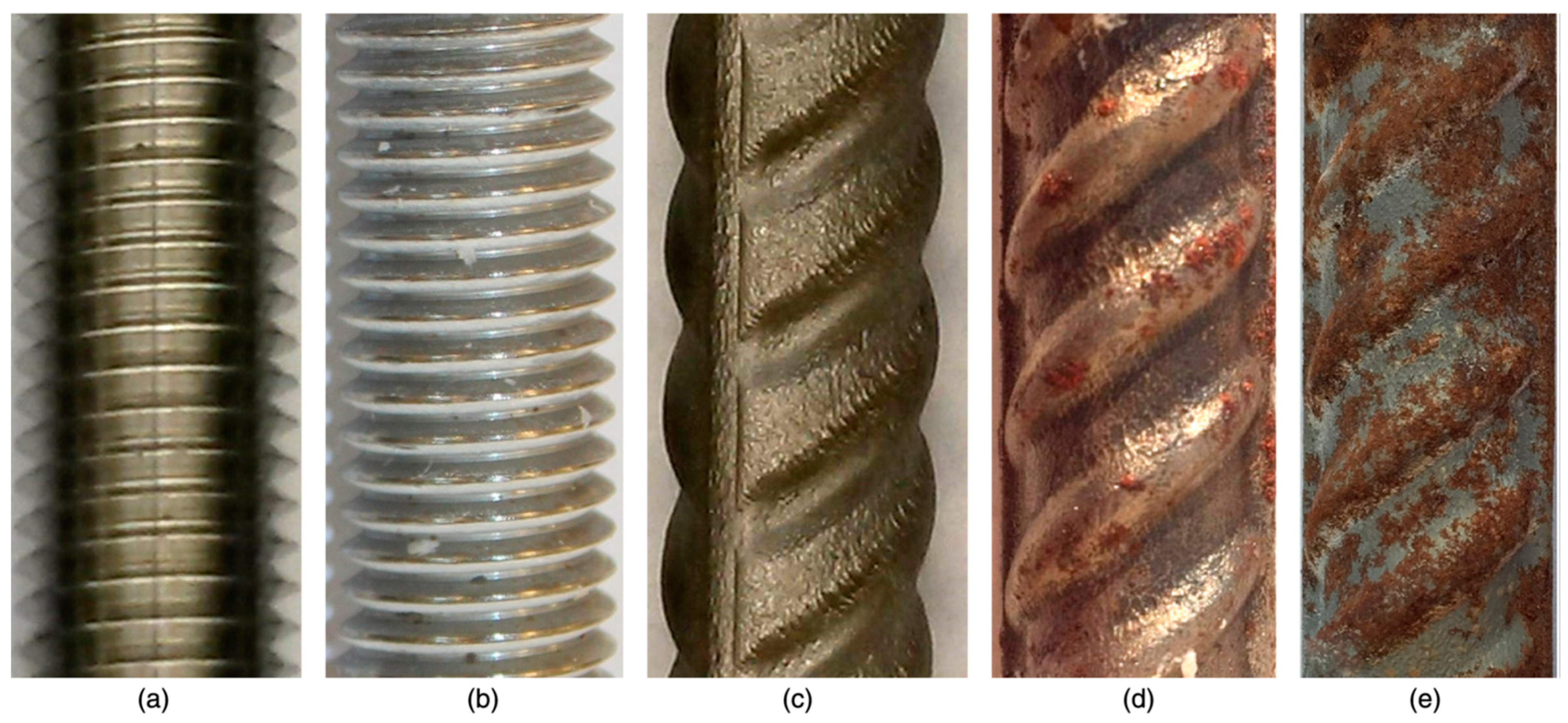
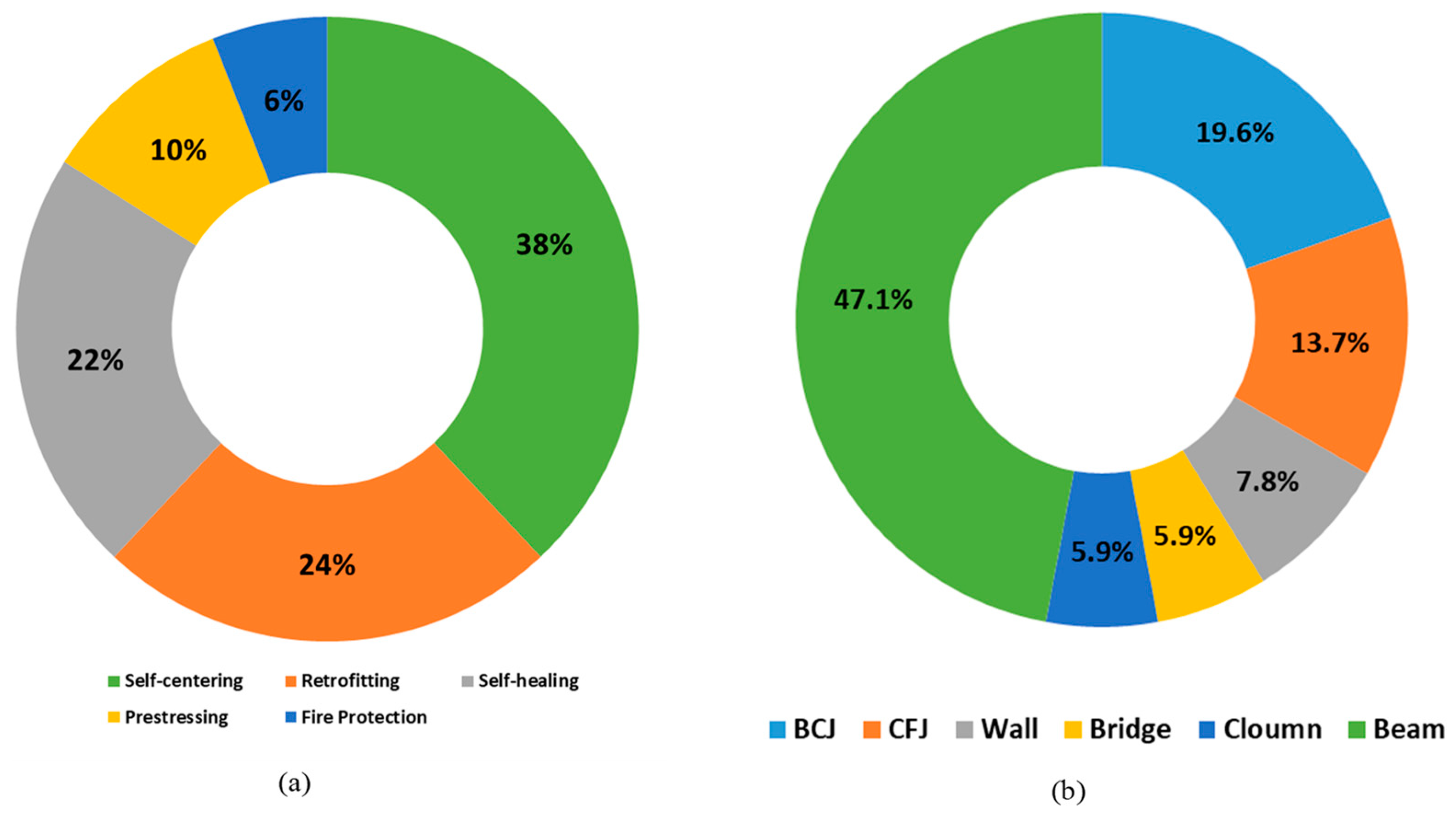
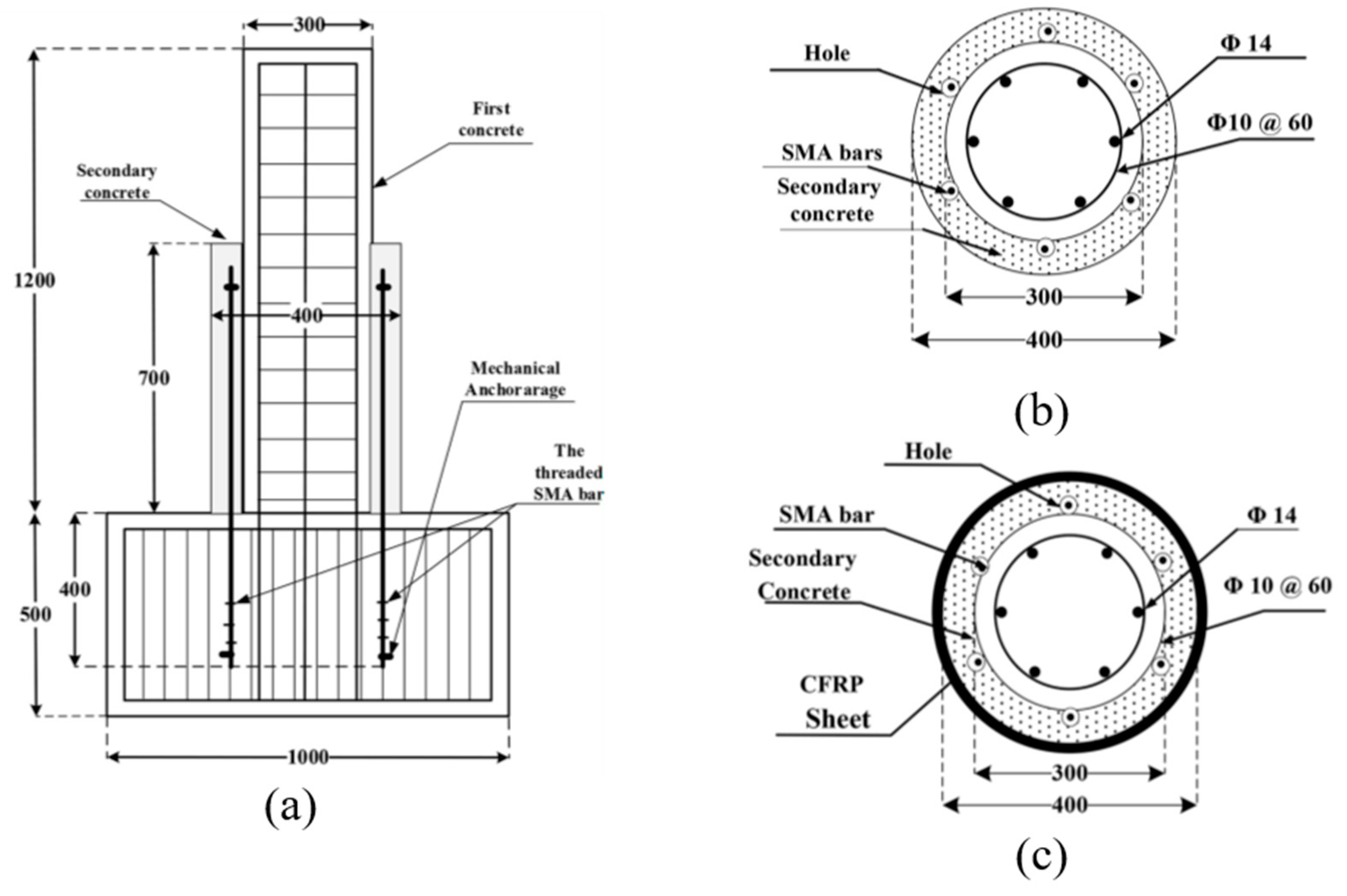




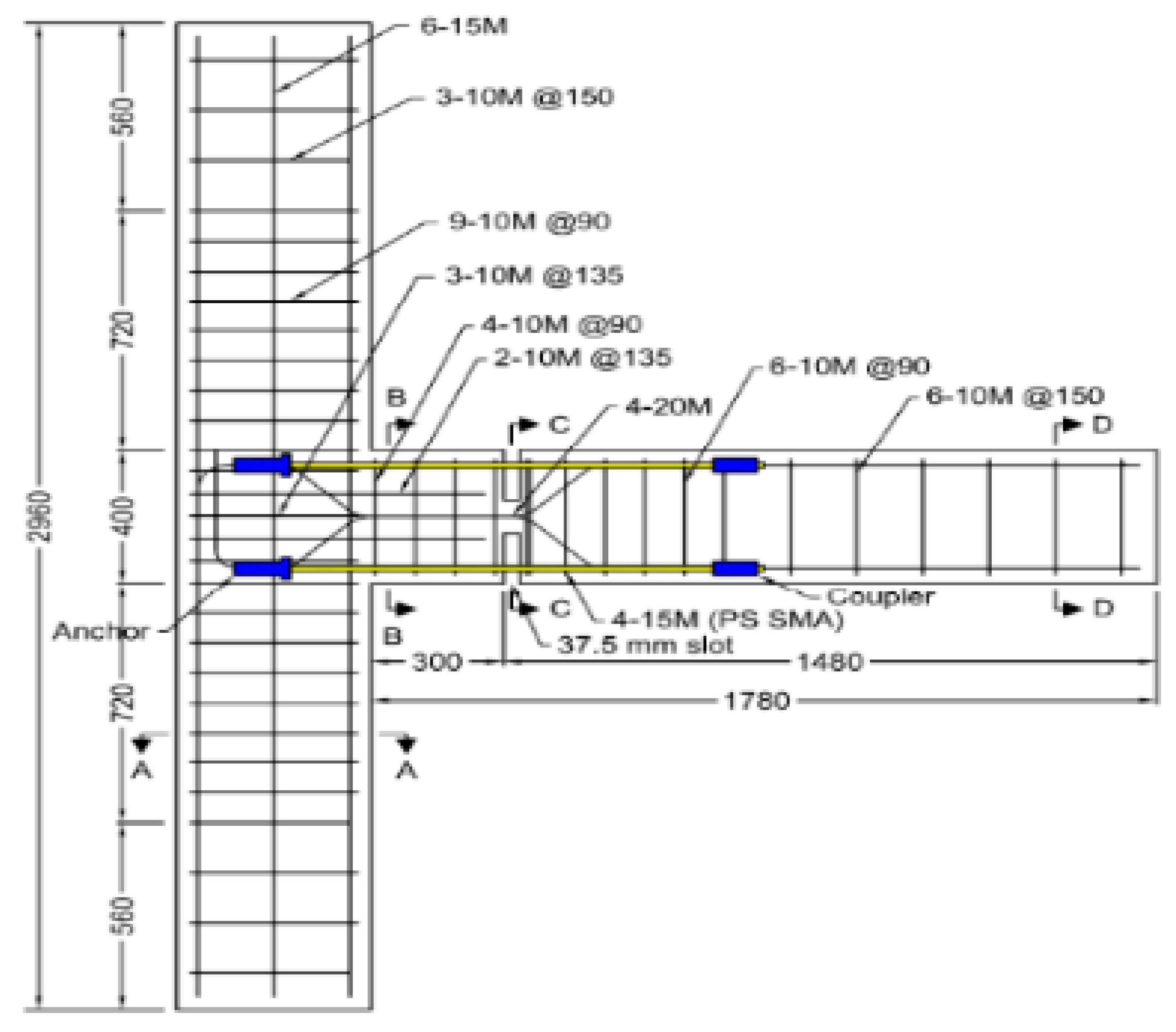

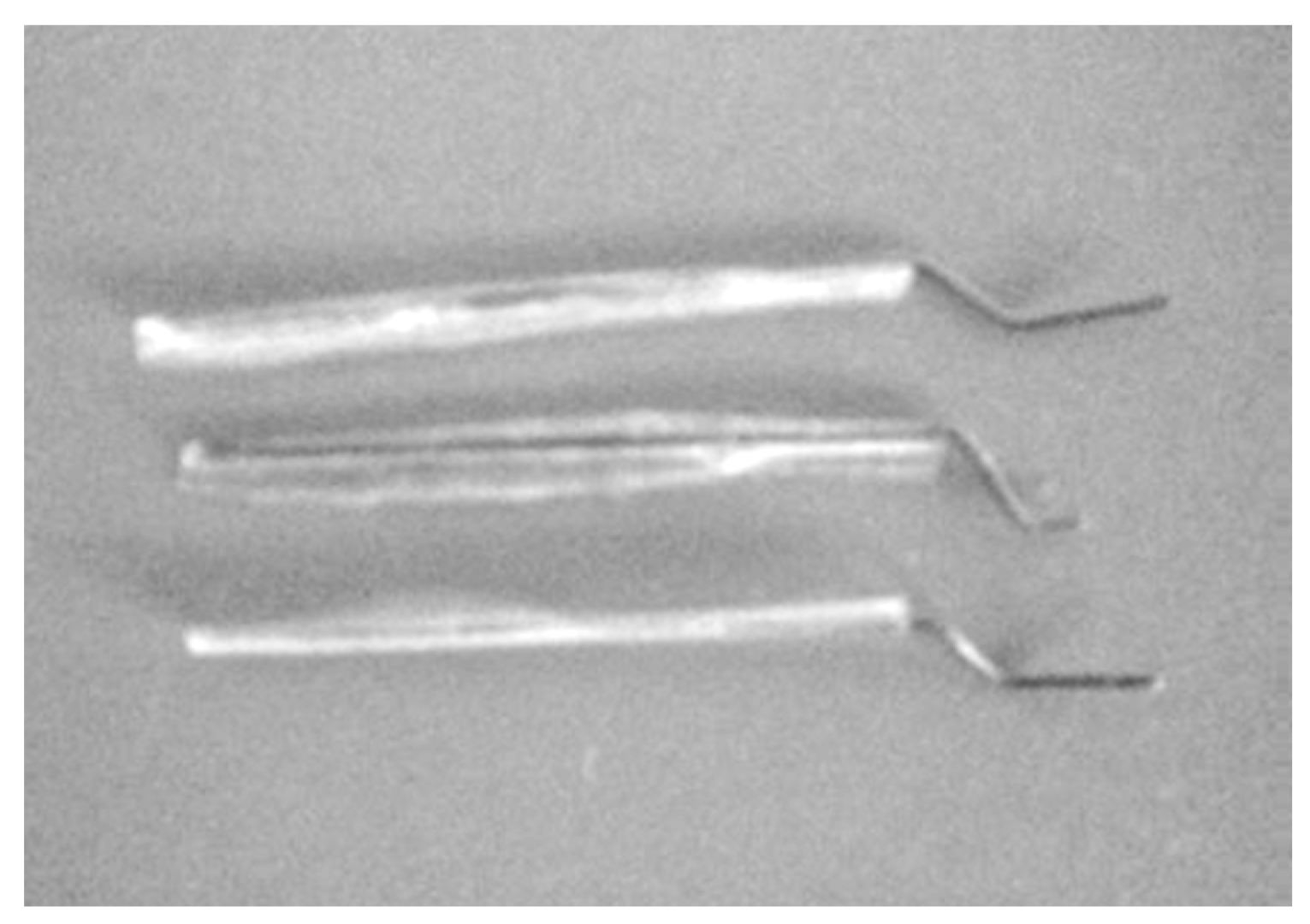
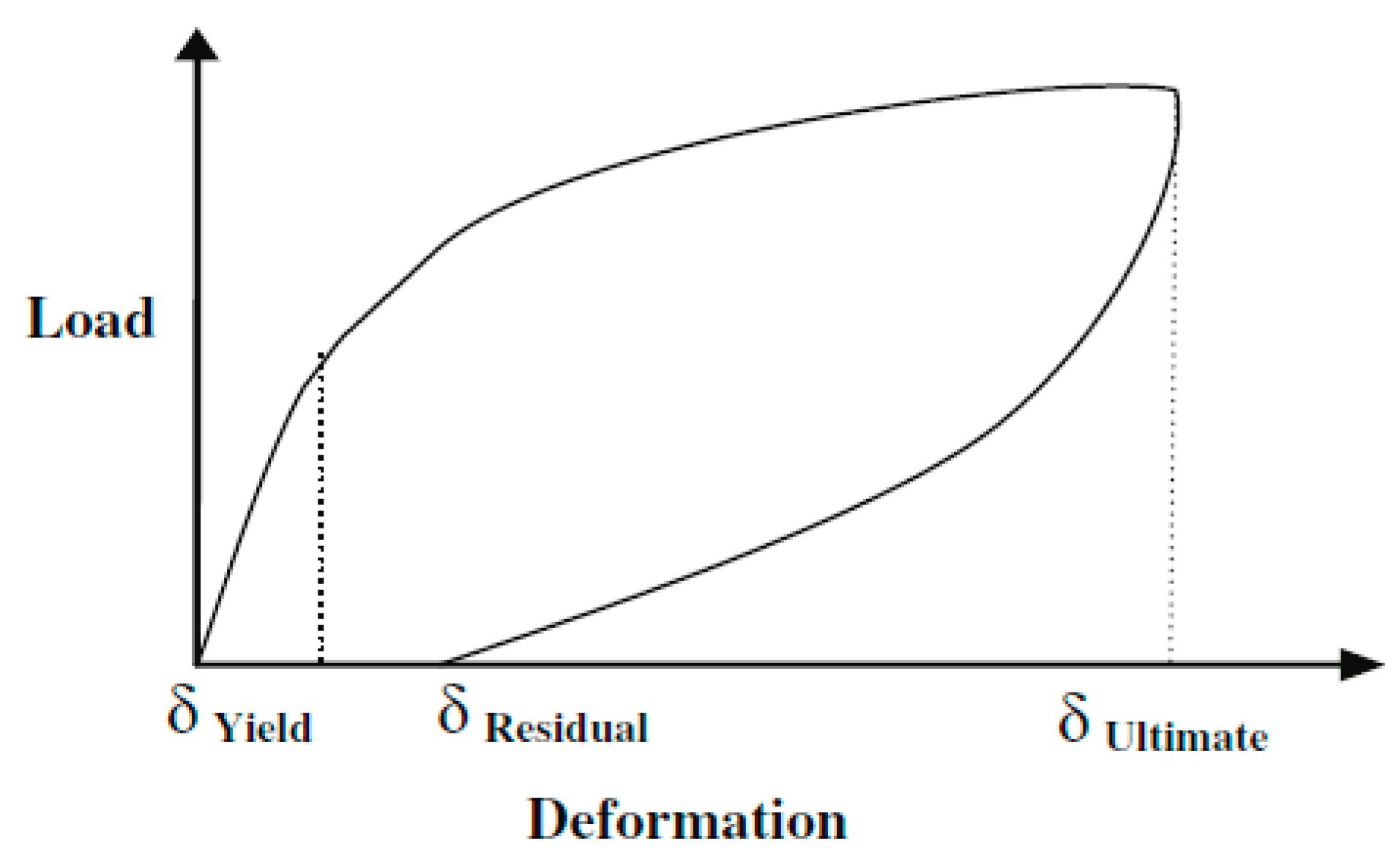
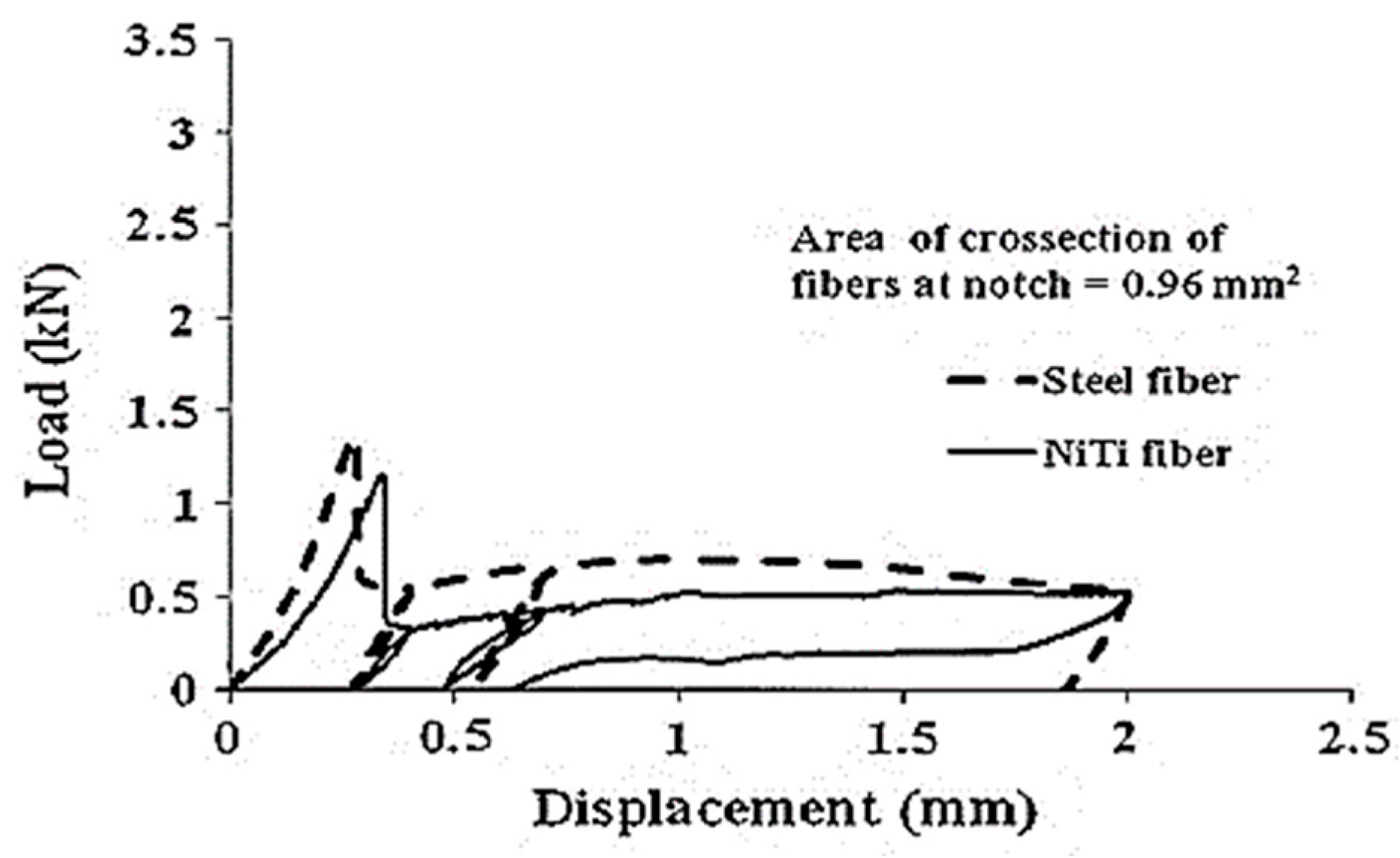
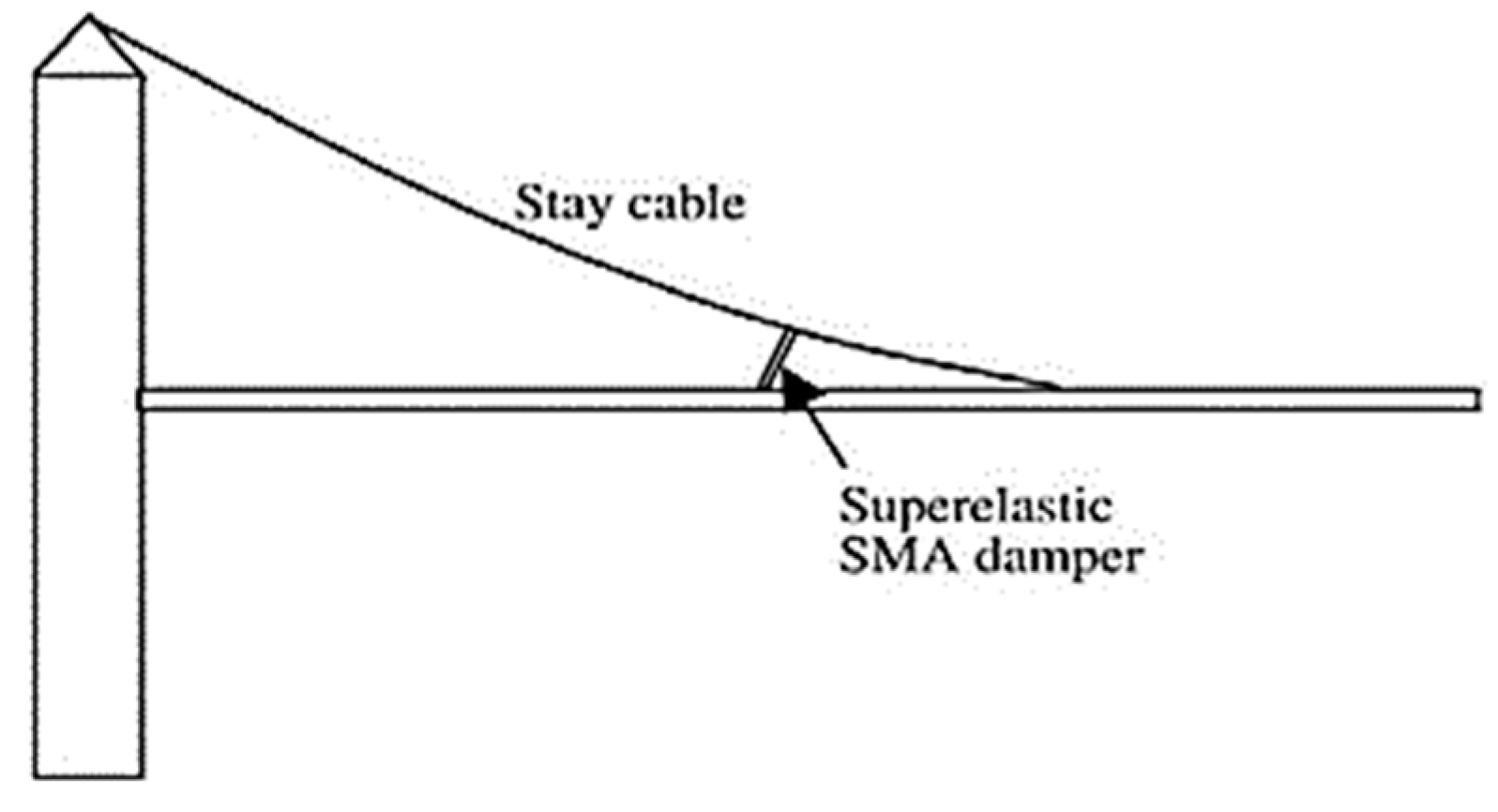

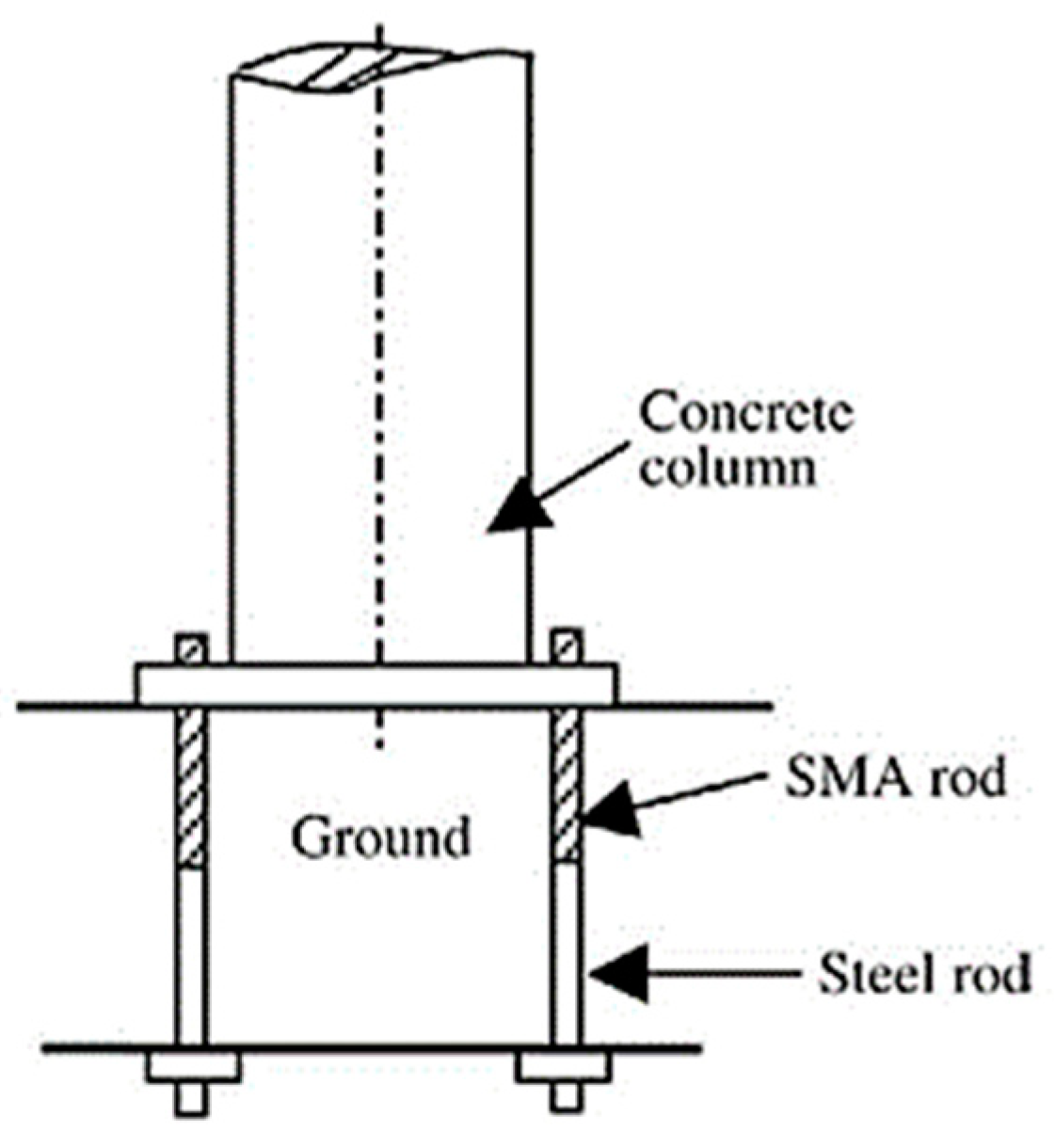

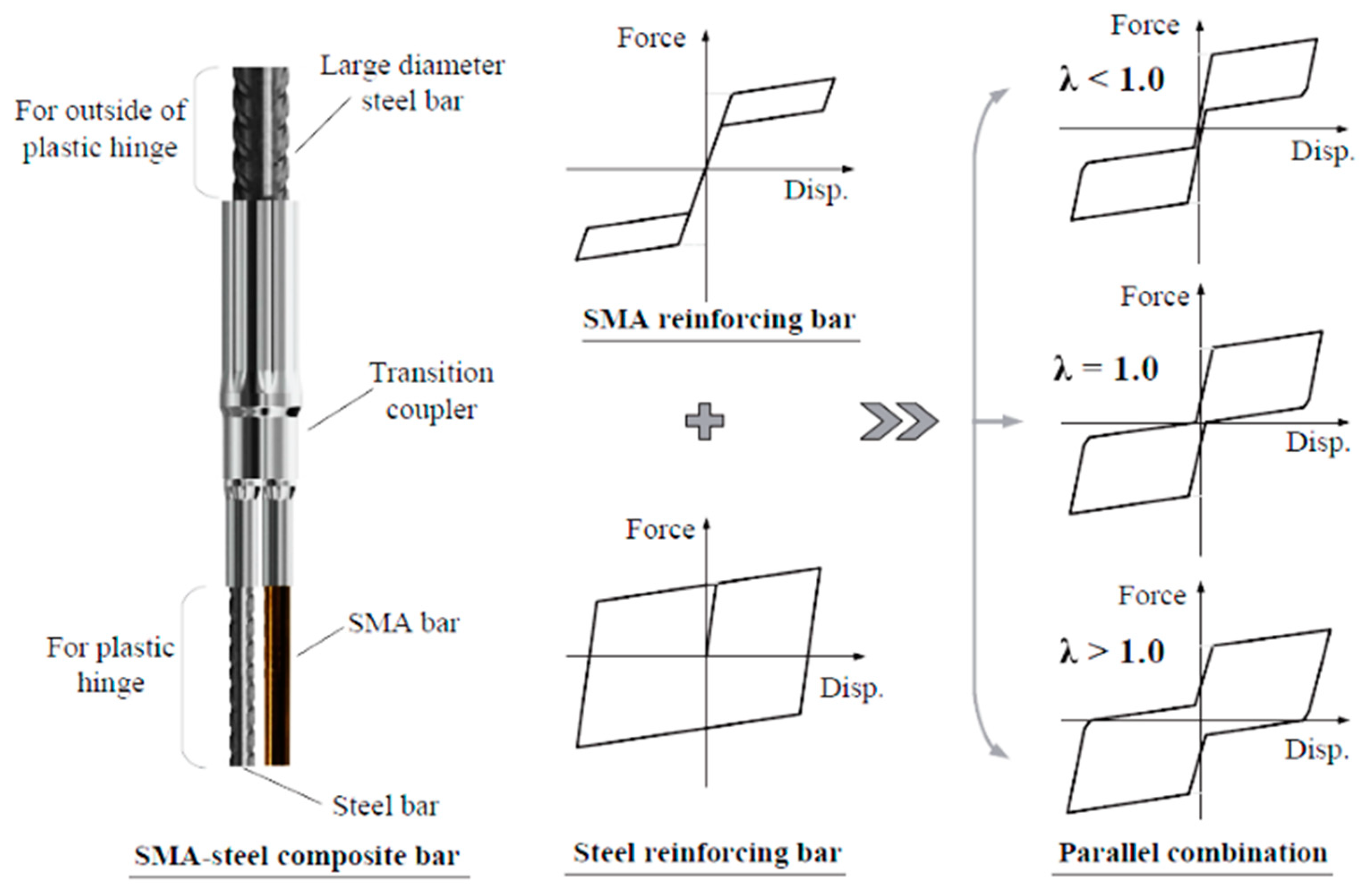


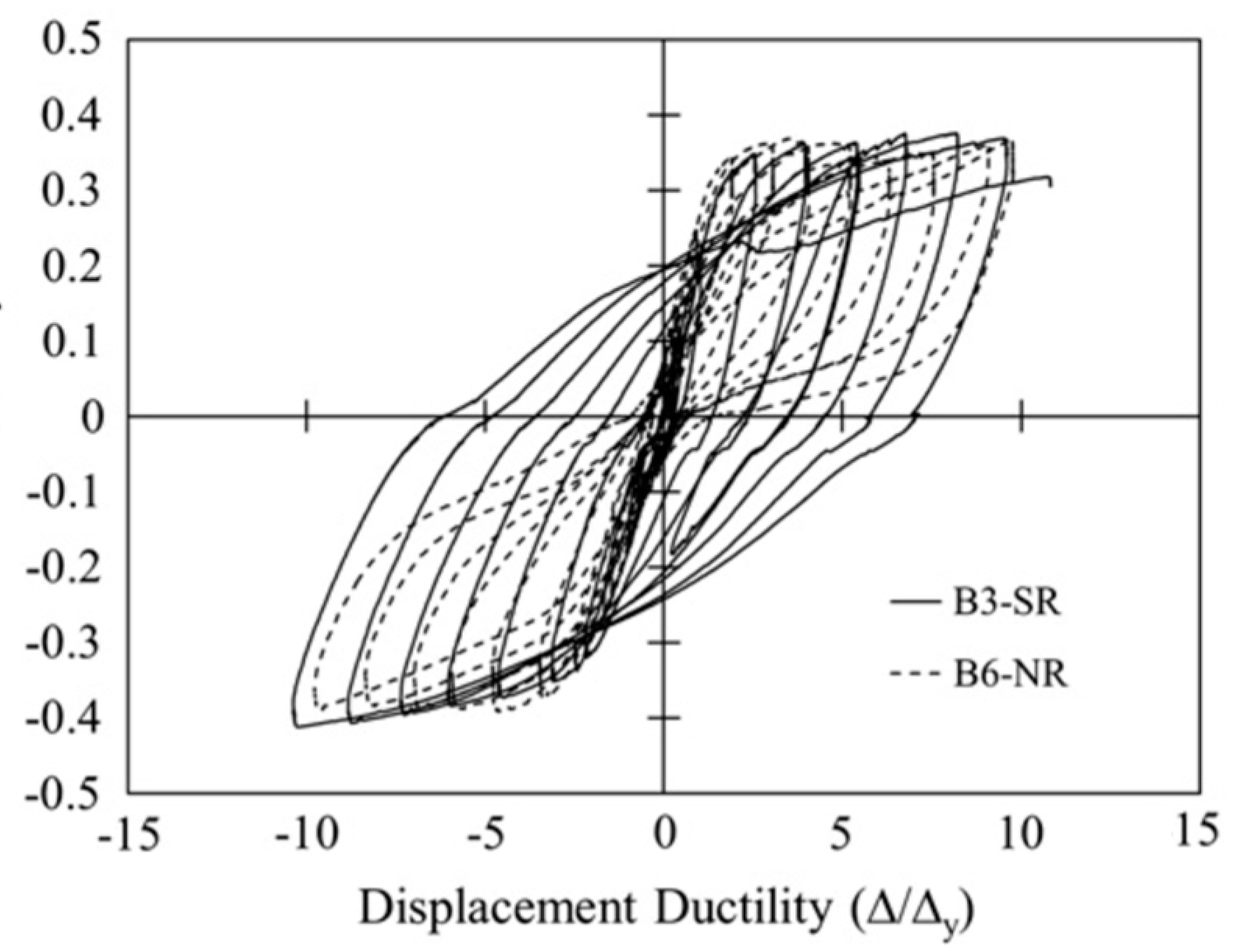
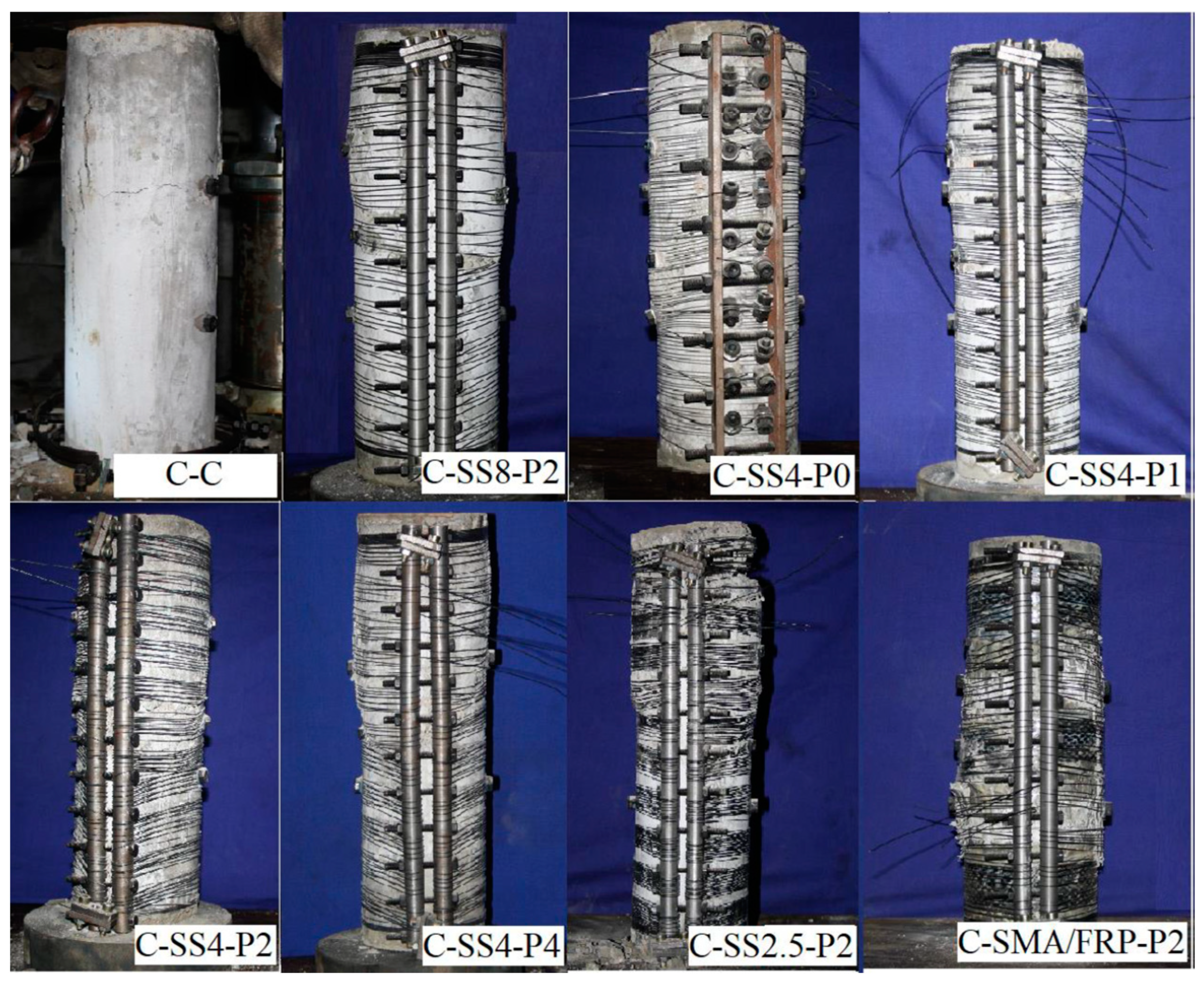
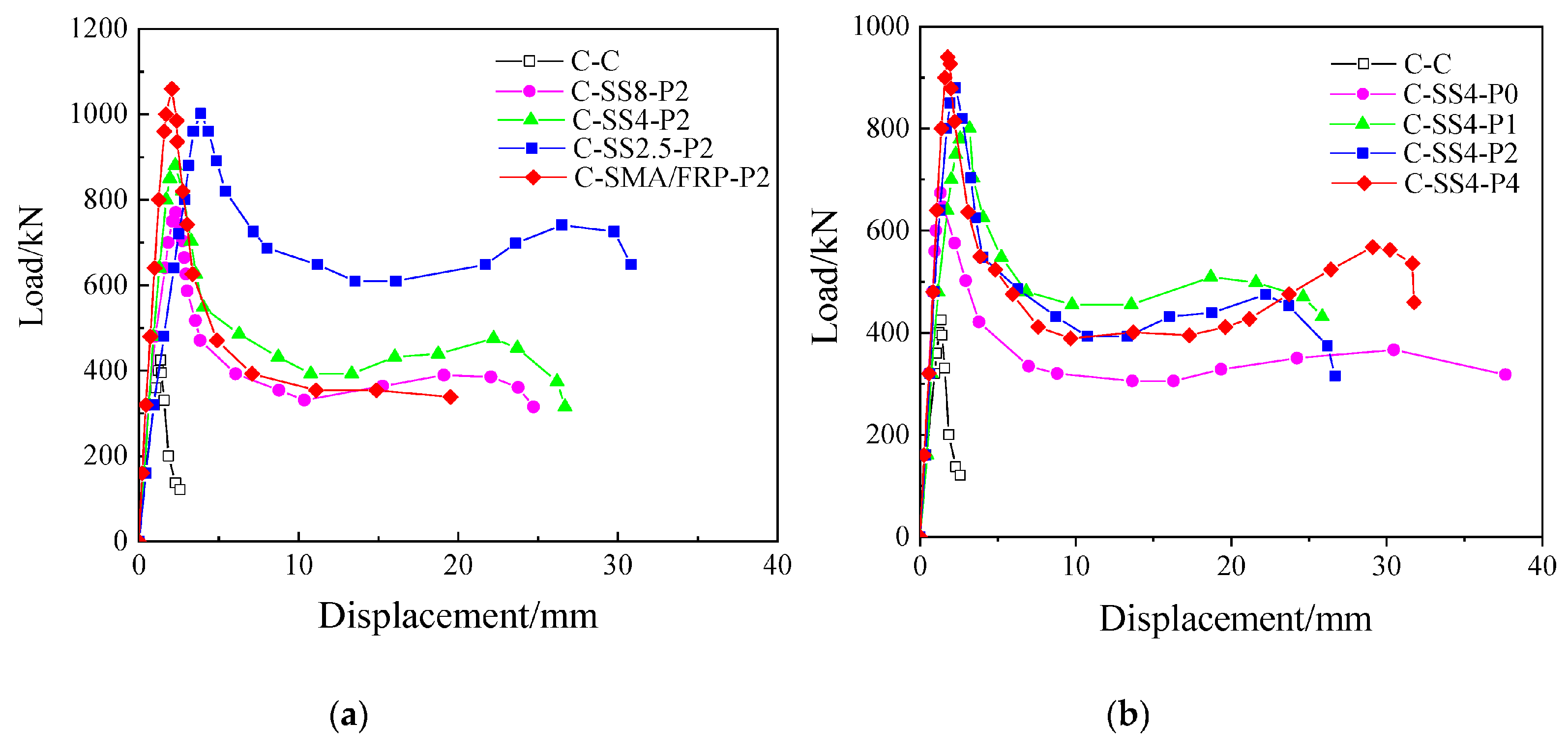
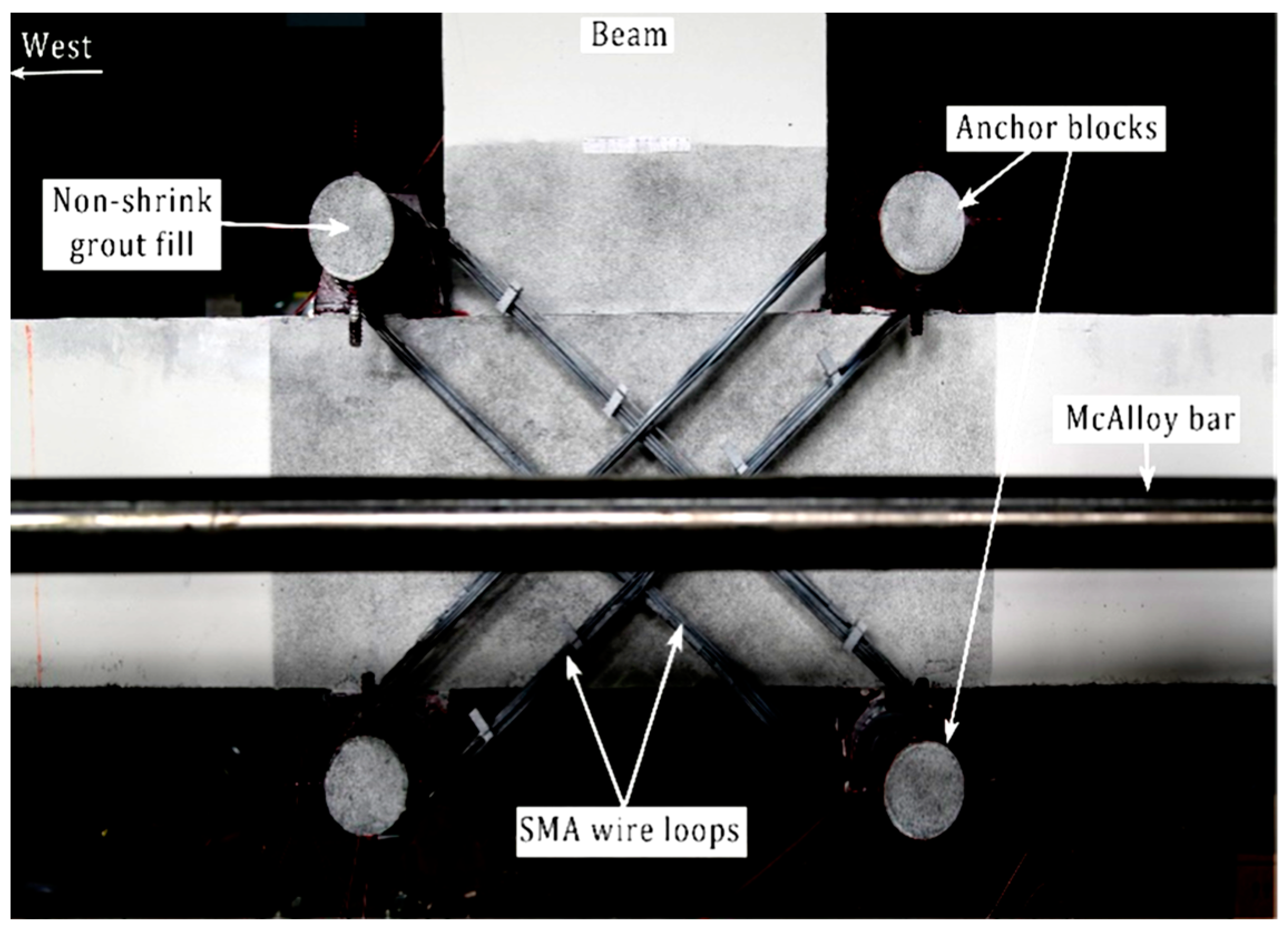
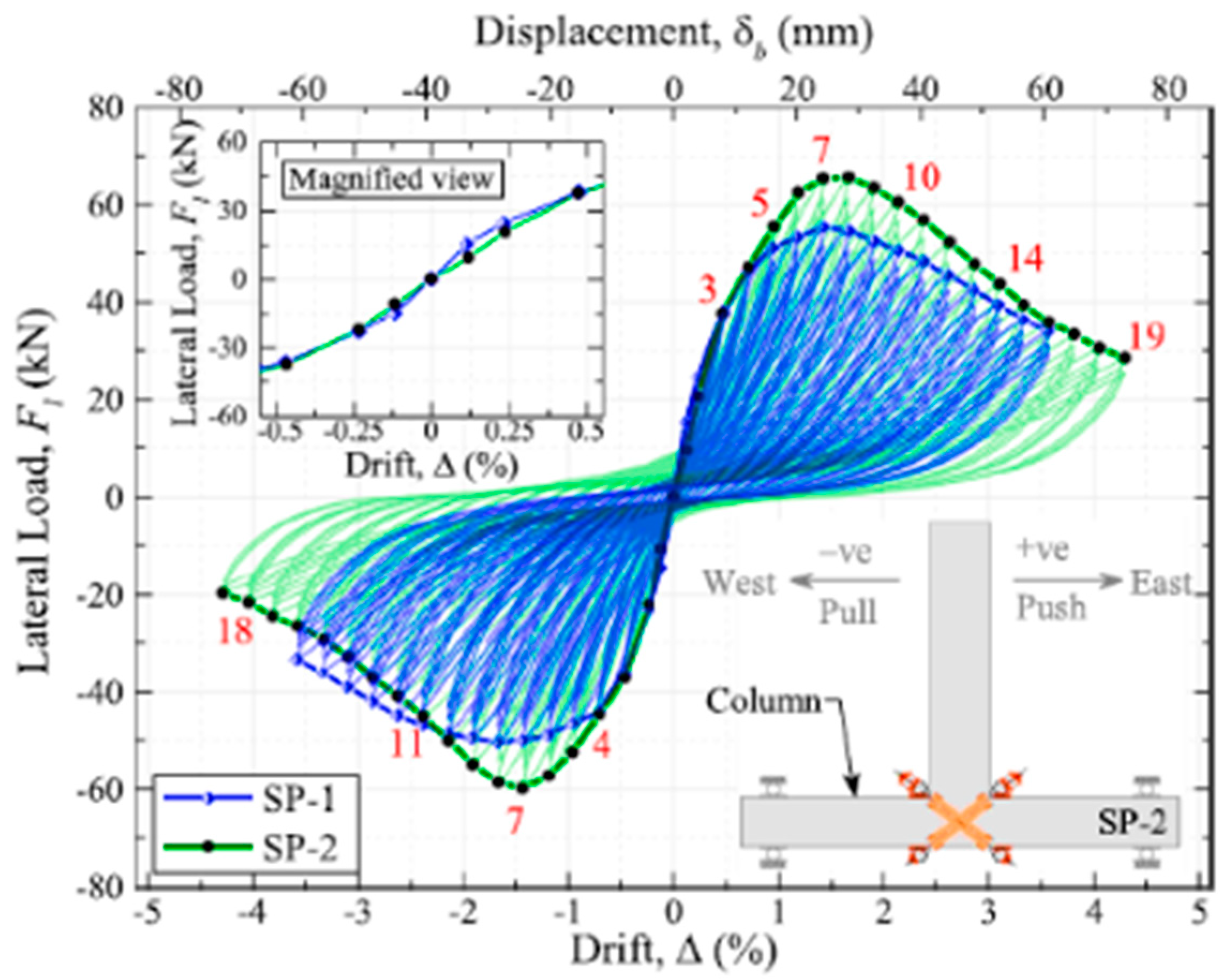
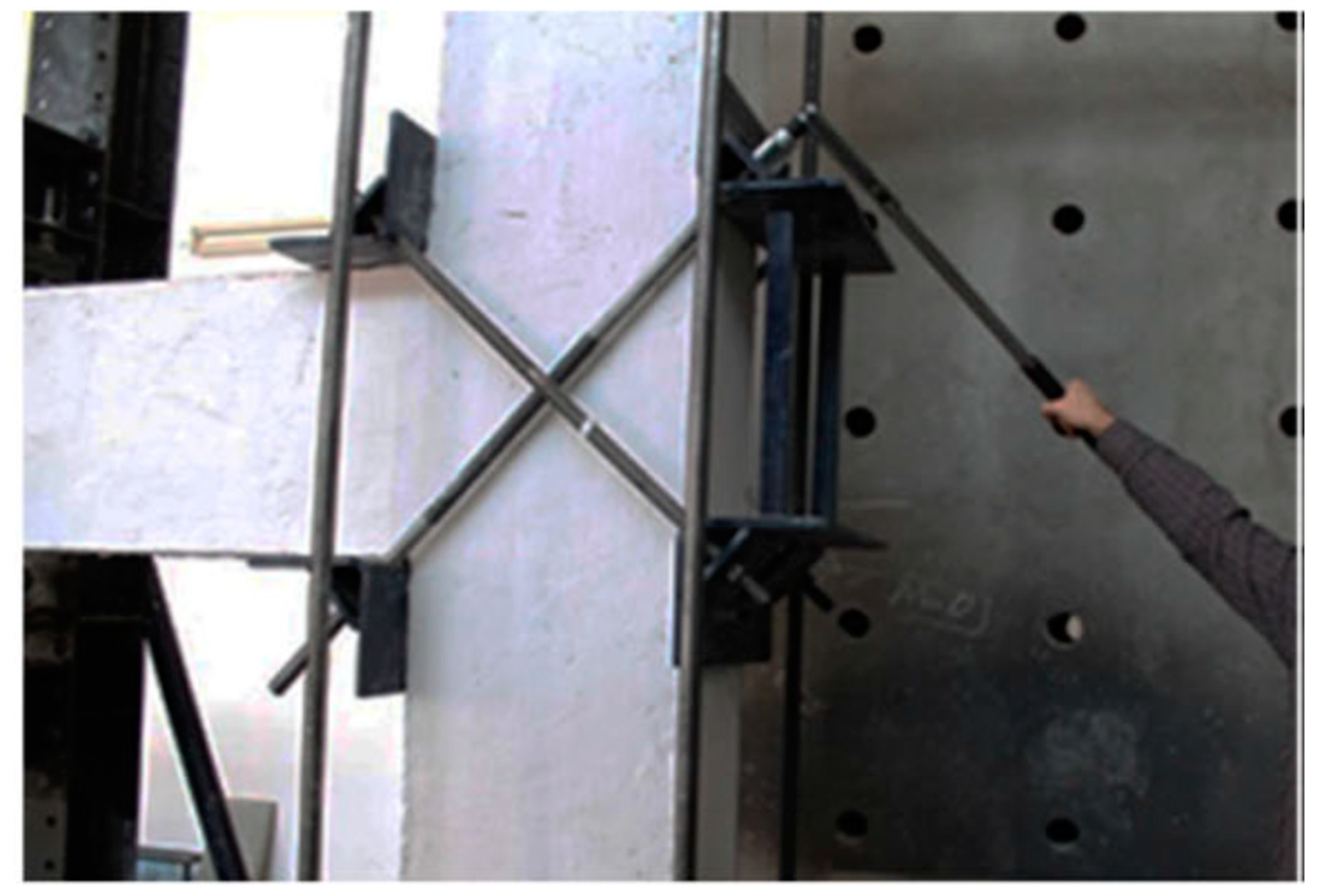
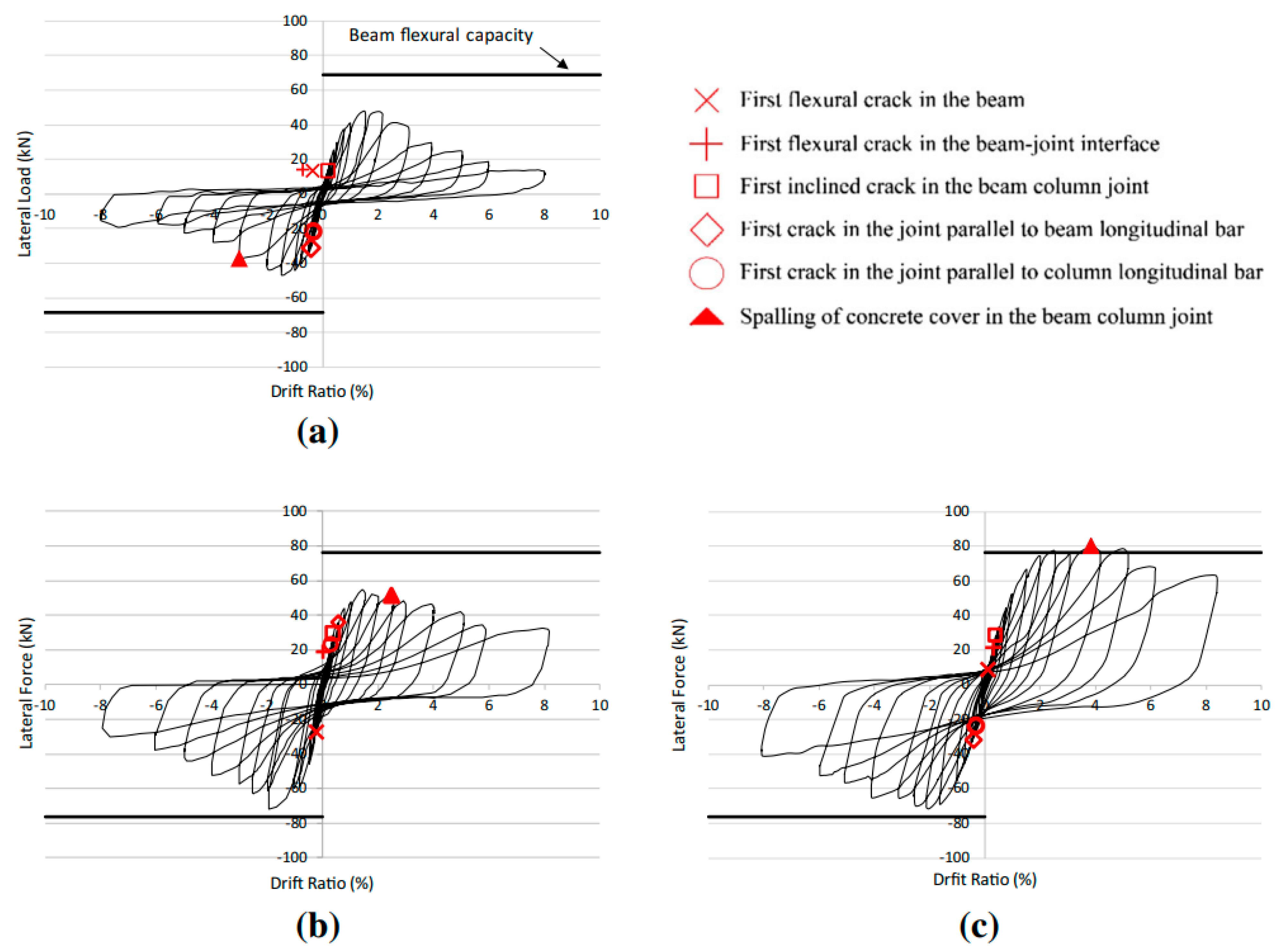

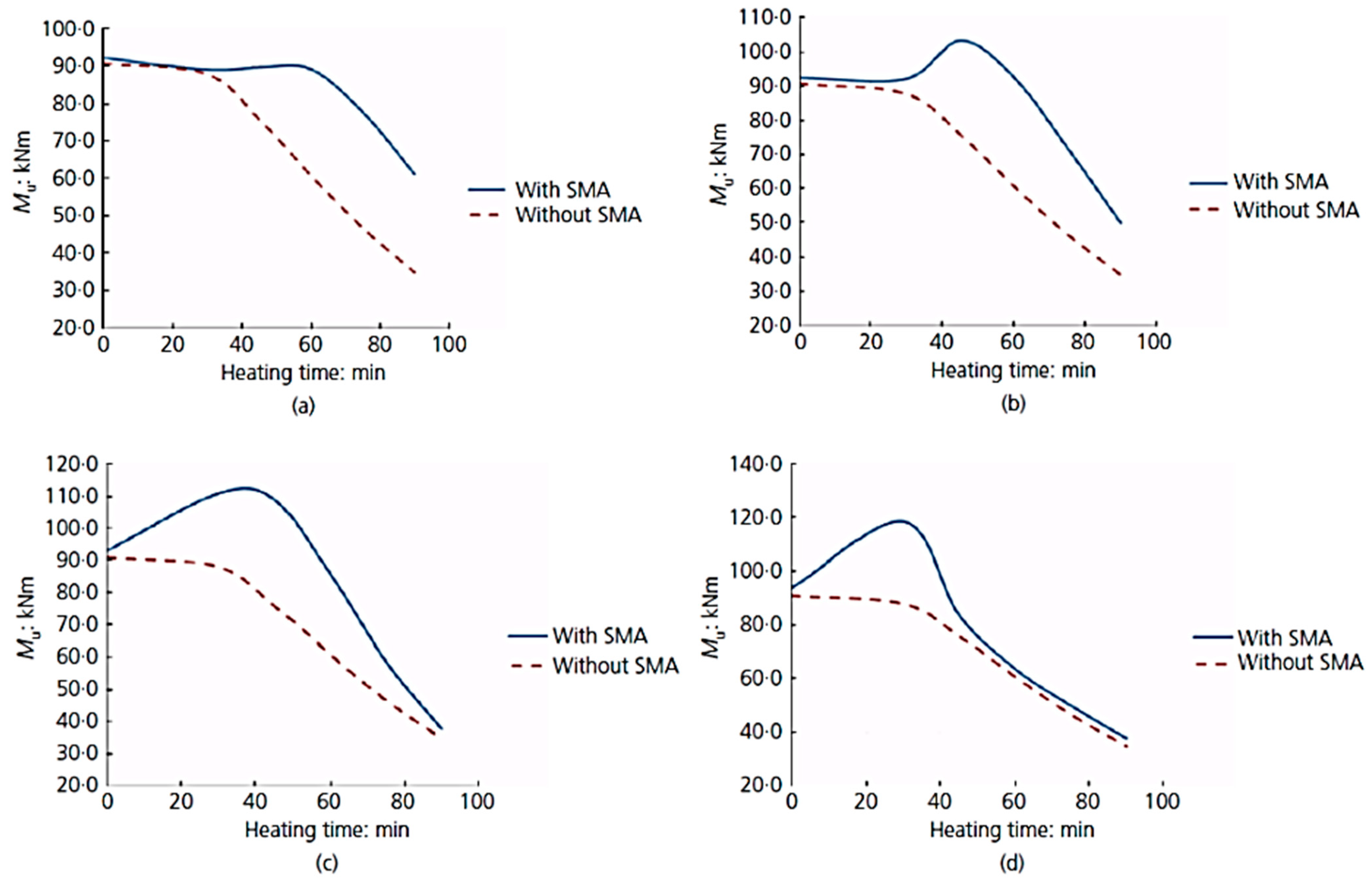
| Element Type | Type of SMA | Ultimate Stress (MPa) | Yield Stress (MPa) | Recovery Stress (MPa) | Recovery Strain | Elastic Modulus (GPa) | Reference |
|---|---|---|---|---|---|---|---|
| Fiber/wire | NiTi | 915 | 350 | 130 | 6% | 31 | [27] |
| 1150 | 550 | 200 | 8% | 75 | [28] | ||
| 920 | 560 | 230 | 7% | 60 | [29] | ||
| NiTiNb | 1059 | 635 | 550 | 8% | 83 | [30] | |
| 1030 | 580 | 460 | 5% | 56 | [31] | ||
| Bar | NiTi | 700 | 485 | 260 | 6% | 55 | [32] |
| NR * | 401 | 220 | 6% | 62 | [33] | ||
| 752 | 549 | 140 | 7% | 54 | [34] | ||
| 1068 | 380 | 190 | 6% | 38 | [35] | ||
| 830 | 480 | 250 | 7% | 36 | [36] |
| Number | Structural Member * | Technique | Residual Displacement ** | Energy Dissipation ** | Load Capacity ** | Study Method | Reference |
|---|---|---|---|---|---|---|---|
| 1 | Beam | SMA fiber concrete | 79% decrease | 22% decrease | 8% decrease | Experimental | [28] |
| 2 | CFJ | Strengthening using external SMA bar at plastic hinge | 58% increase | 39% increase | 72% decrease | = | [34] |
| 3 | CFJ | SMA bars at the plastic hinge using normal concrete | 100% decrease | 70% decrease | 8% decrease | Numerical | [84] |
| 4 | CFJ | SMA bars at the plastic hinge using ultra high performance concrete | 100% decrease | 56% decrease | 30% increase | = | [84] |
| 5 | CFJ | Strengthening using external SMA bar at plastic hinge and concrete jacketing | 25% decrease | 88% increase | 183% increase | = | [85] |
| 6 | CFJ | Strengthening using external SMA bar at plastic hinge and ECC jacketing | 40% decrease | 110% increase | 230% increase | = | [85] |
| 7 | BCJ | SMA bar at plastic hinge | 75% decrease | 37% decrease | 3% increase | Experimental | [33] |
| 8 | BCJ | SMA bar at plastic hinge with slots | 86% decrease | 43% decrease | 4% decrease | = | [32] |
| 9 | Shear wall | SMA bars at the plastic hinge | 42% decrease | 21% decrease | 15% decrease | = | [35] |
| 10 | Shear wall | SMA bars at the plastic hinge with steel angle for precast wall | 87% decrease | 17% decrease | 10% increase | Numerical | [36] |
| 11 | Bridge | NiTi SMA rubber bearings | 84% decrease | 30% increase | 20% increase | = | [86] |
| 12 | Bridge | SMA bars at the plastic hinge near footing | 88% decrease | 73% decrease | 7% decrease | = | [87] |
| 13 | Bridge | SMA–steel bars at the plastic hinge near footing | 75% decrease | 48% decrease | 7% decrease | = | [87] |
| # | SMA Element | Study Type | Application | Type of Loading | Technique | Findings | Reference |
|---|---|---|---|---|---|---|---|
| 1 | Washer | Experimental | Pier | Reversed cyclic | SMA-washer-based piers | The novel system showed low damage, negligible residual deformation, and protection against over-rocking. | [92] |
| 2 | Wire | Experimental | Damper | Dynamic by shake table | SMA damper for cable-stayed bridges between the tower and the deck | SMA damper reduced the tower accelerations, relative displacements, and the bending moments. | [93] |
| 3 | Cable | Experimental | Girder | Dynamic by shake table | SMA restrainer cables in-span hinges of box girder | SMA restrainer cables had slight residual strain with little strength and stiffness degradation after repeated loading | [94] |
| 4 | Bar | Experimental | Pier | Reversed cyclic | SMA bars and engineered cementitious composites (ECCs) at plastic hinge | The reduction in residual displacement was 83% when a combination of SMA bars and ECC was used in the plastic hinge zone, while the reduction was only 67% for conventional concrete and SMA. | [95] |
| 5 | Bar | Experimental | Pier | Dynamic by shake table | SMA bars and engineered cementitious composites (ECC) at plastic hinge | SMA minimized residual displacement, and the hybrid use of ECC and SMA was found to reduce significnatly the earthquake damage. | [96] |
| 6 | Bar | Numerical | Pier | Reversed cyclic | post-tensioned precast segmental bridge piers using SMA bars | SMA bars provided self-centering capability, increased the hysteretic energy dissipation, and achieved high ductile behavior. | [97] |
| 7 | Bar | Numerical | Pier | Reversed cyclic | SMA bars at plastic hinge | The SMA RC bridge pier showed superior performance to bridge piers reinforced with steel bars alone. | [98] |
| 8 | Wire | Numerical | Isolation device | Reversed cyclic | SMA-based rubber bearing | Residual displacement of the deck was reduced after moderate and strong earthquakes. Pier displacements were smaller, while deck displacement, bearing displacement, and deck acceleration were significantly larger. | [86] |
| 9 | Cable | Numerical | Restrainer | Cyclic | SMA-based restrainer | SMA devices were able to eliminate residual joint openings. | [99] |
| 10 | Bar | Numerical | Isolation device | Reversed cyclic | Laminated rubber bearing with a device made of SMA | The SMA isolation system had self-centering ability. For a medium-size earthquake, the SMA bars increased the damping capacity, whereas the SMA bars provided hysteretic damping and acted as a controlling device for a large earthquake. | [100] |
| 11 | Bar | Numerical | Pier | Reversed cyclic | SMA–steel bars at the plastic hinge near footing | The innovative SMA–steel coupled reinforcing bar showed similar effectiveness to the pure SMA bar in reducing the residual drift, while dissipating higher energy compared to pure SMA reinforcement. | [87] |
| # | Structural Member * | Technique | Load Capacity ** | Energy Dissipation ** | Ductility ** | Study Method | Reference |
|---|---|---|---|---|---|---|---|
| 1 | BCJ | Diagonal prestressed SMA loops at the joint | 18% increase | 56% increase | 5% decrease | Experimental | [30] |
| 2 | BCJ | Diagonal post-tension SMA bars | 70% increase | 160% increase | 35% increase | Experimental | [102] |
Disclaimer/Publisher’s Note: The statements, opinions and data contained in all publications are solely those of the individual author(s) and contributor(s) and not of MDPI and/or the editor(s). MDPI and/or the editor(s) disclaim responsibility for any injury to people or property resulting from any ideas, methods, instructions or products referred to in the content. |
© 2023 by the authors. Licensee MDPI, Basel, Switzerland. This article is an open access article distributed under the terms and conditions of the Creative Commons Attribution (CC BY) license (https://creativecommons.org/licenses/by/4.0/).
Share and Cite
Alshannag, M.J.; Alqarni, A.S.; Higazey, M.M. Superelastic Nickel–Titanium (NiTi)-Based Smart Alloys for Enhancing the Performance of Concrete Structures. Materials 2023, 16, 4333. https://doi.org/10.3390/ma16124333
Alshannag MJ, Alqarni AS, Higazey MM. Superelastic Nickel–Titanium (NiTi)-Based Smart Alloys for Enhancing the Performance of Concrete Structures. Materials. 2023; 16(12):4333. https://doi.org/10.3390/ma16124333
Chicago/Turabian StyleAlshannag, Mohammad J., Ali S. Alqarni, and Mahmoud M. Higazey. 2023. "Superelastic Nickel–Titanium (NiTi)-Based Smart Alloys for Enhancing the Performance of Concrete Structures" Materials 16, no. 12: 4333. https://doi.org/10.3390/ma16124333
APA StyleAlshannag, M. J., Alqarni, A. S., & Higazey, M. M. (2023). Superelastic Nickel–Titanium (NiTi)-Based Smart Alloys for Enhancing the Performance of Concrete Structures. Materials, 16(12), 4333. https://doi.org/10.3390/ma16124333










